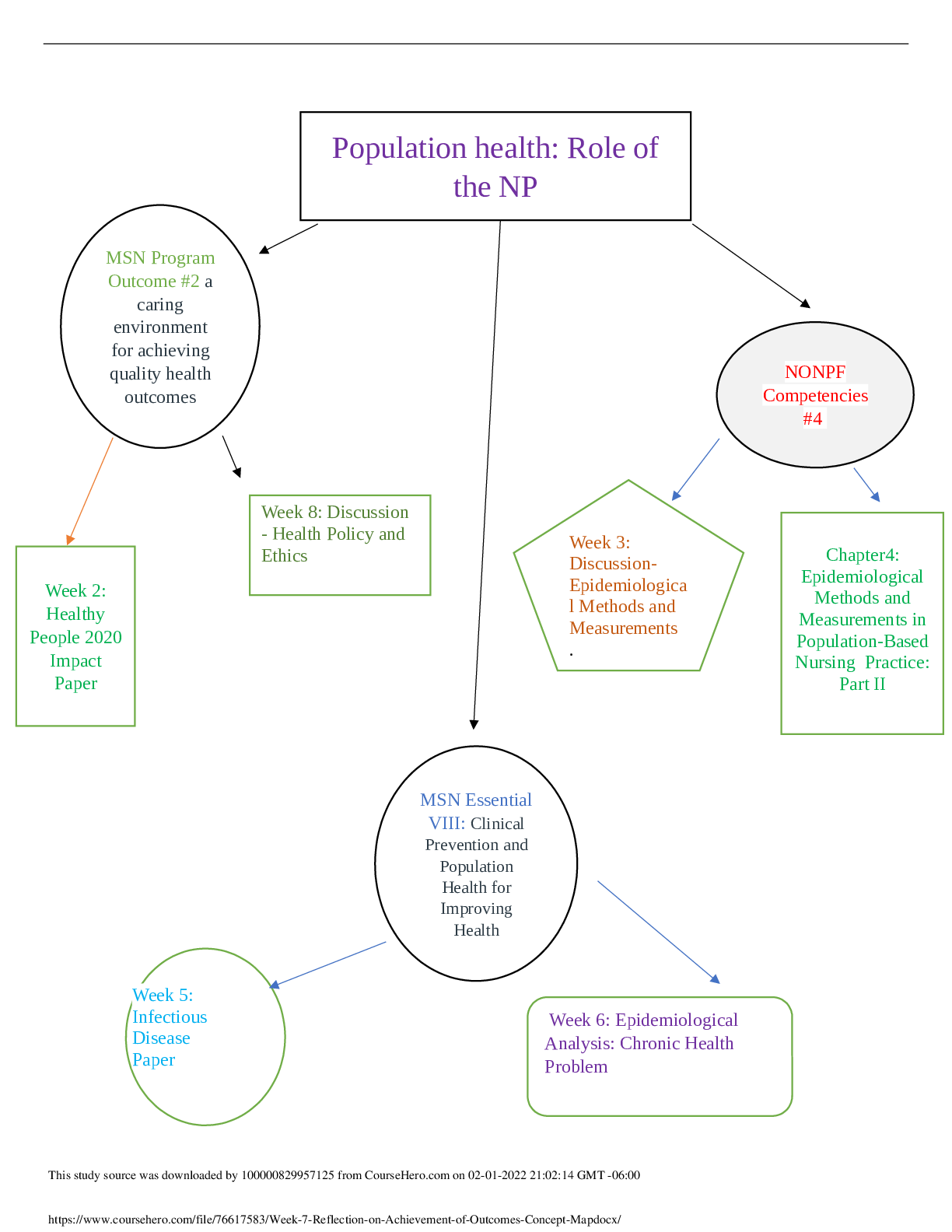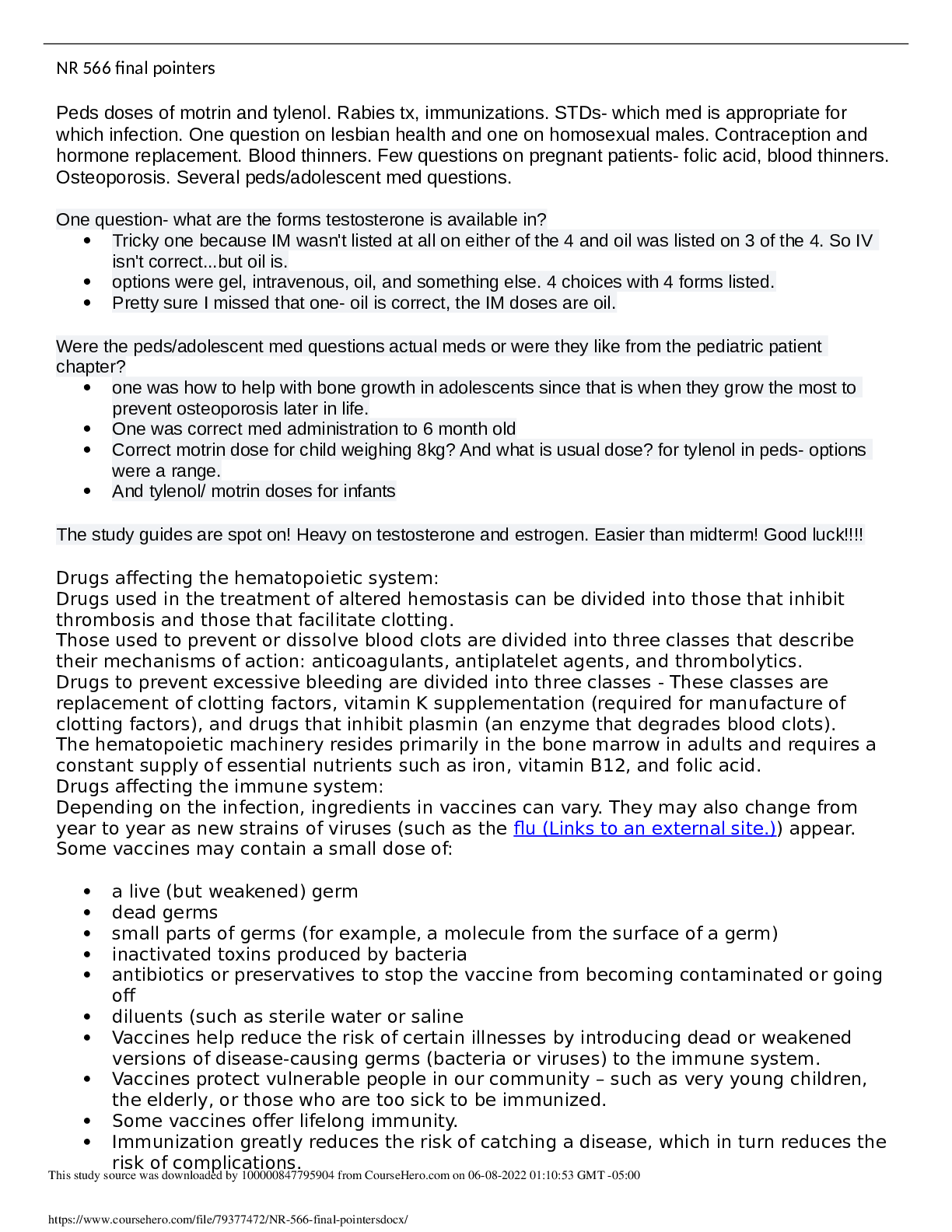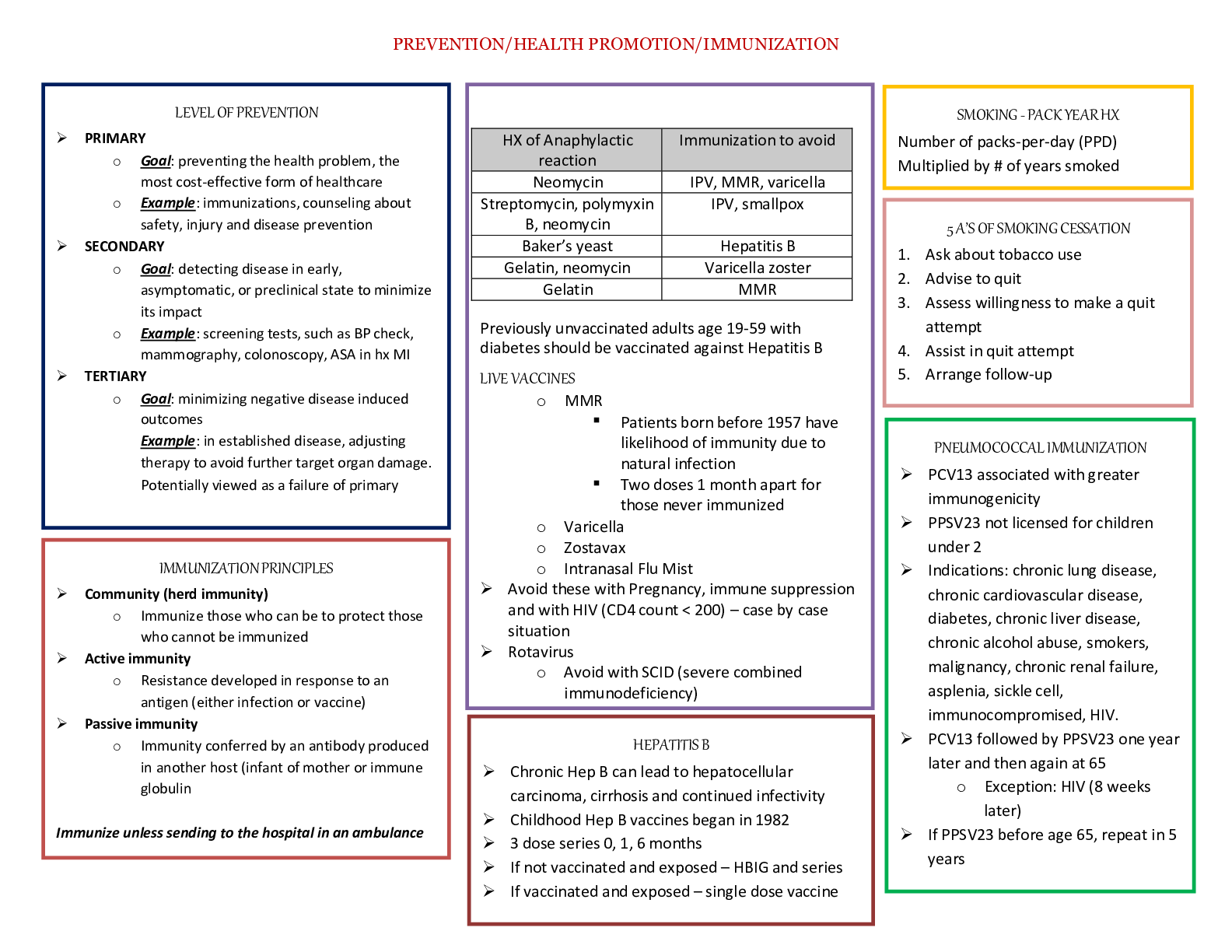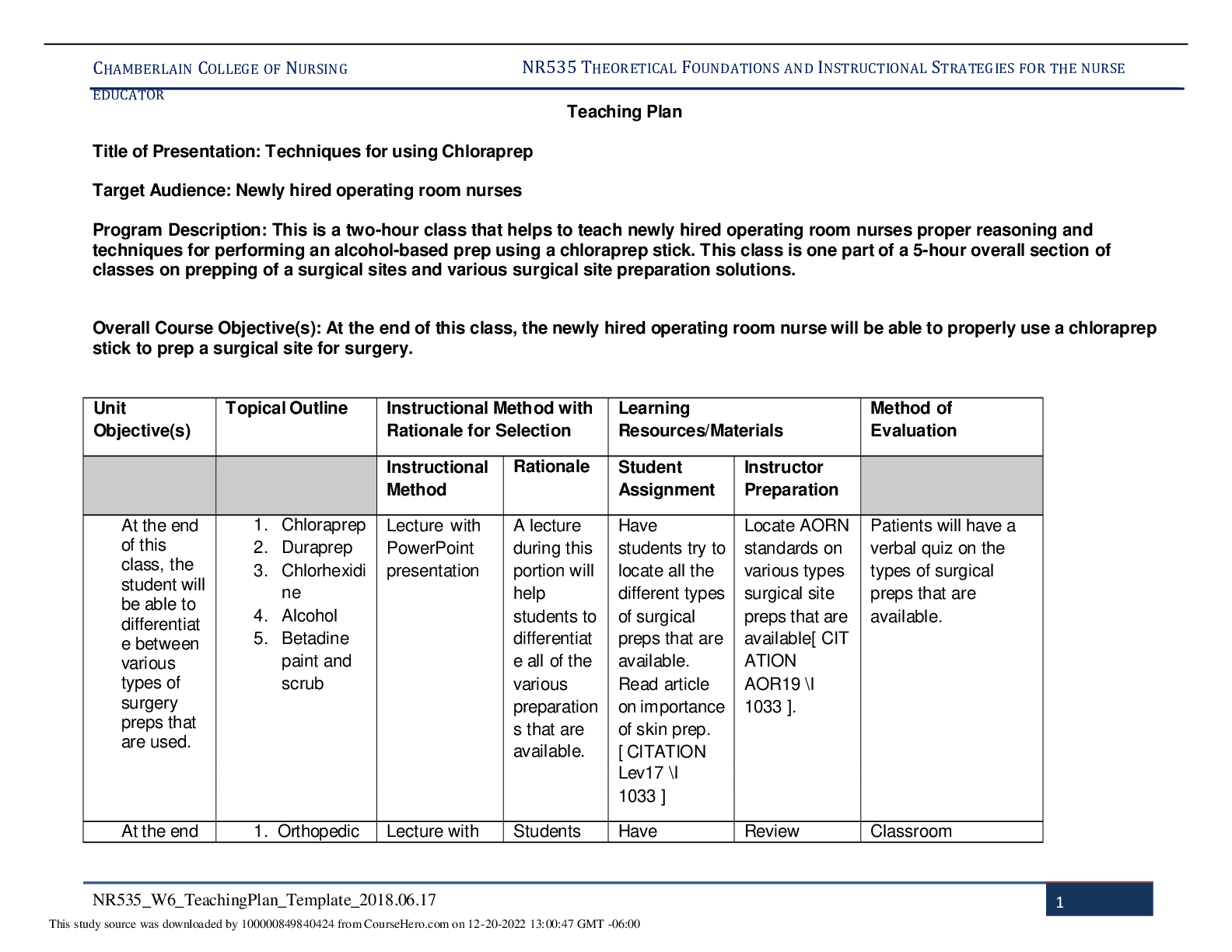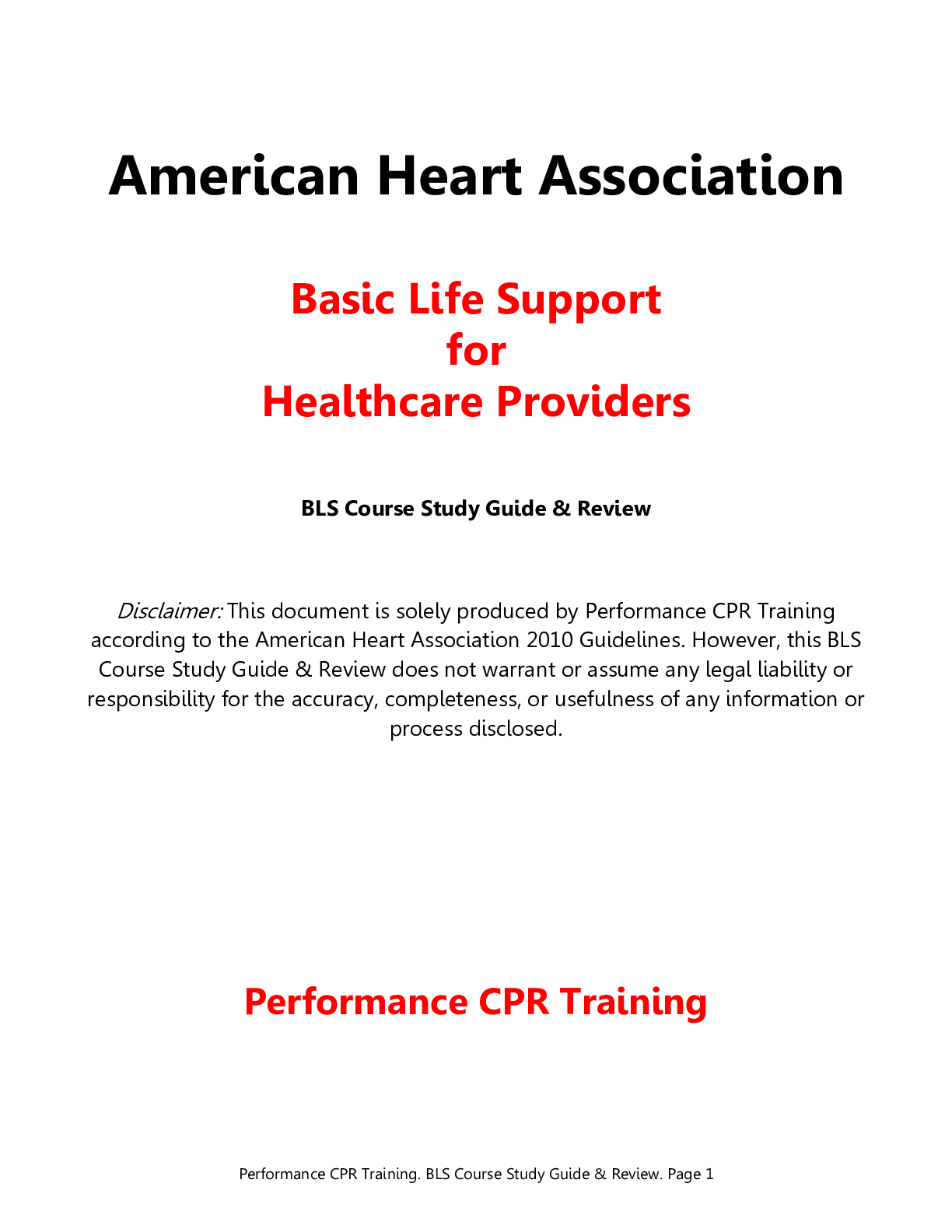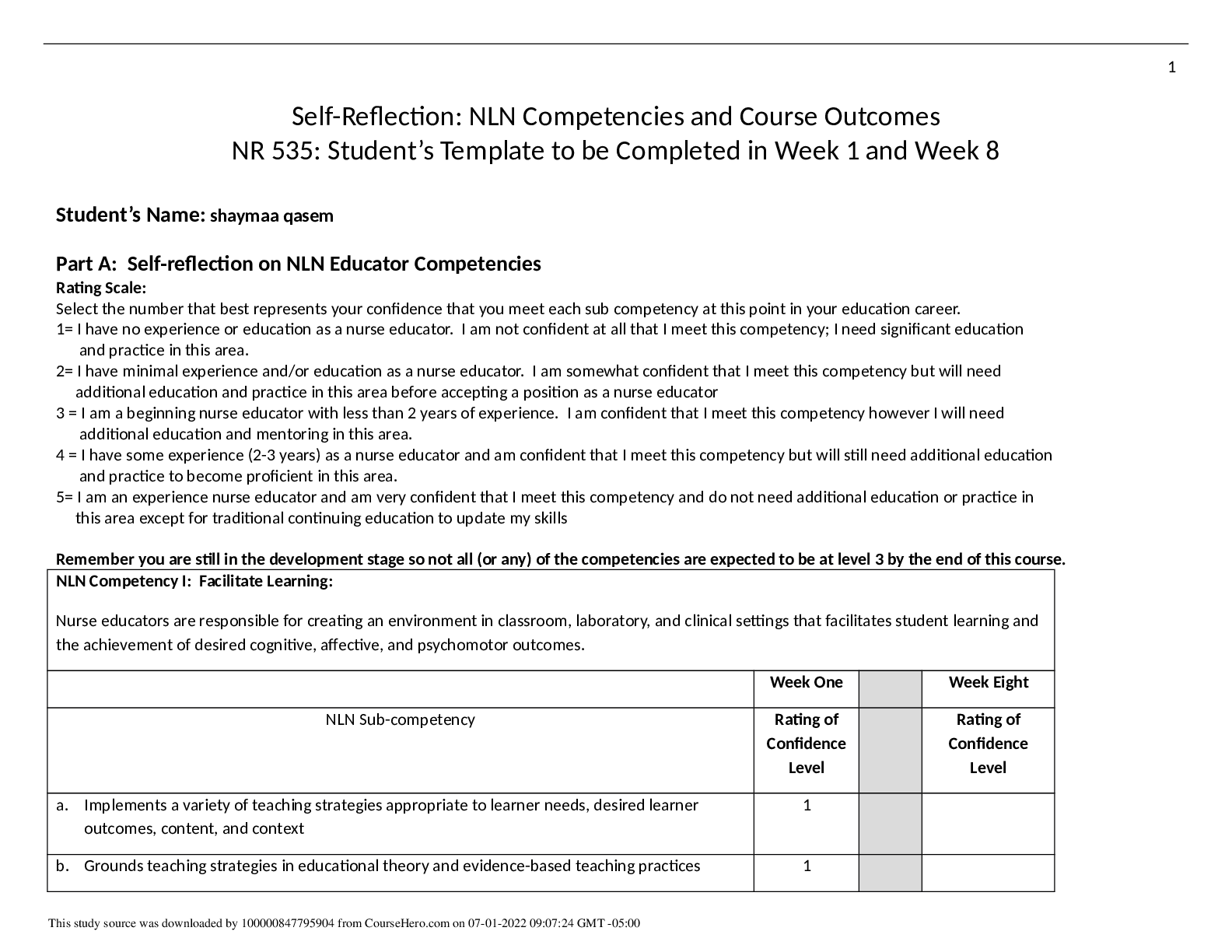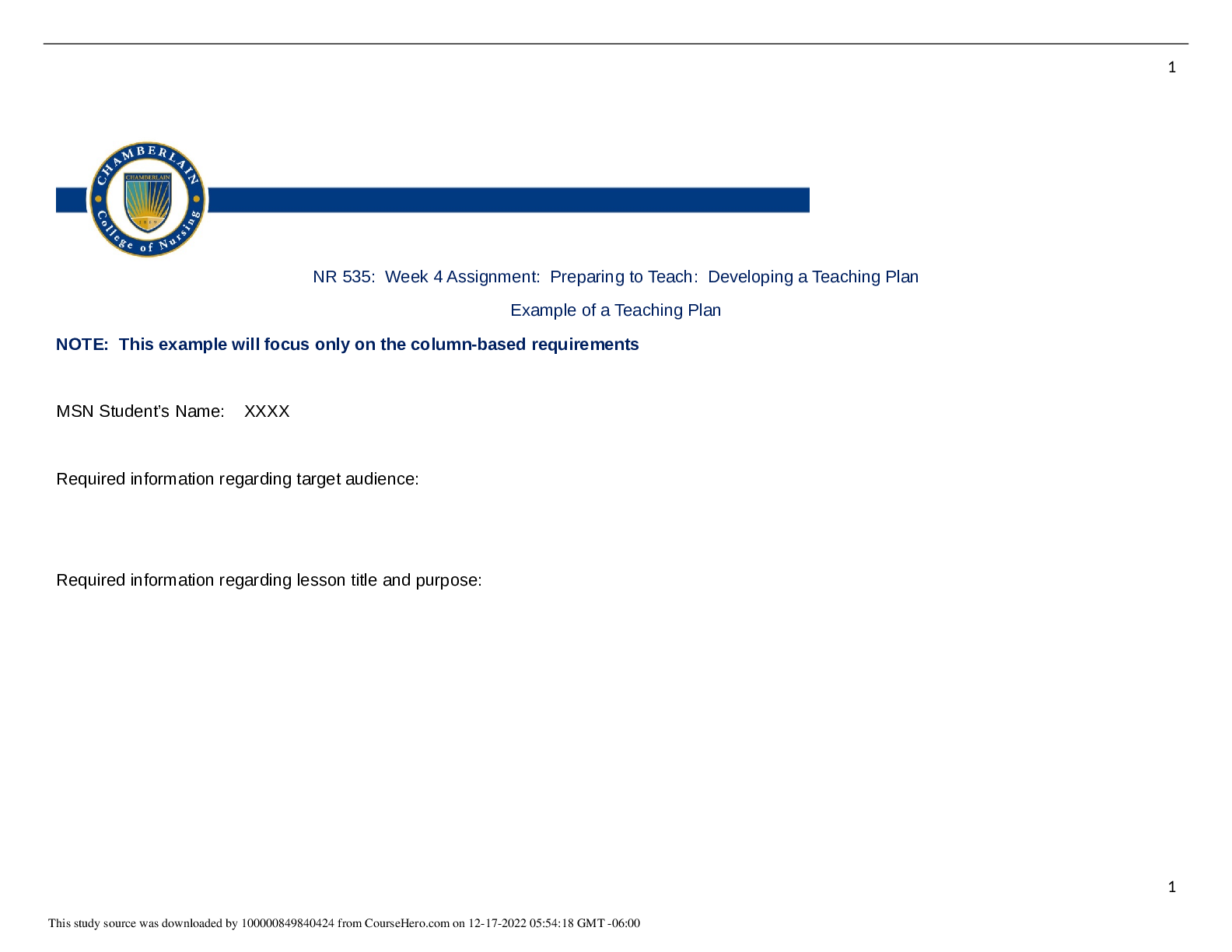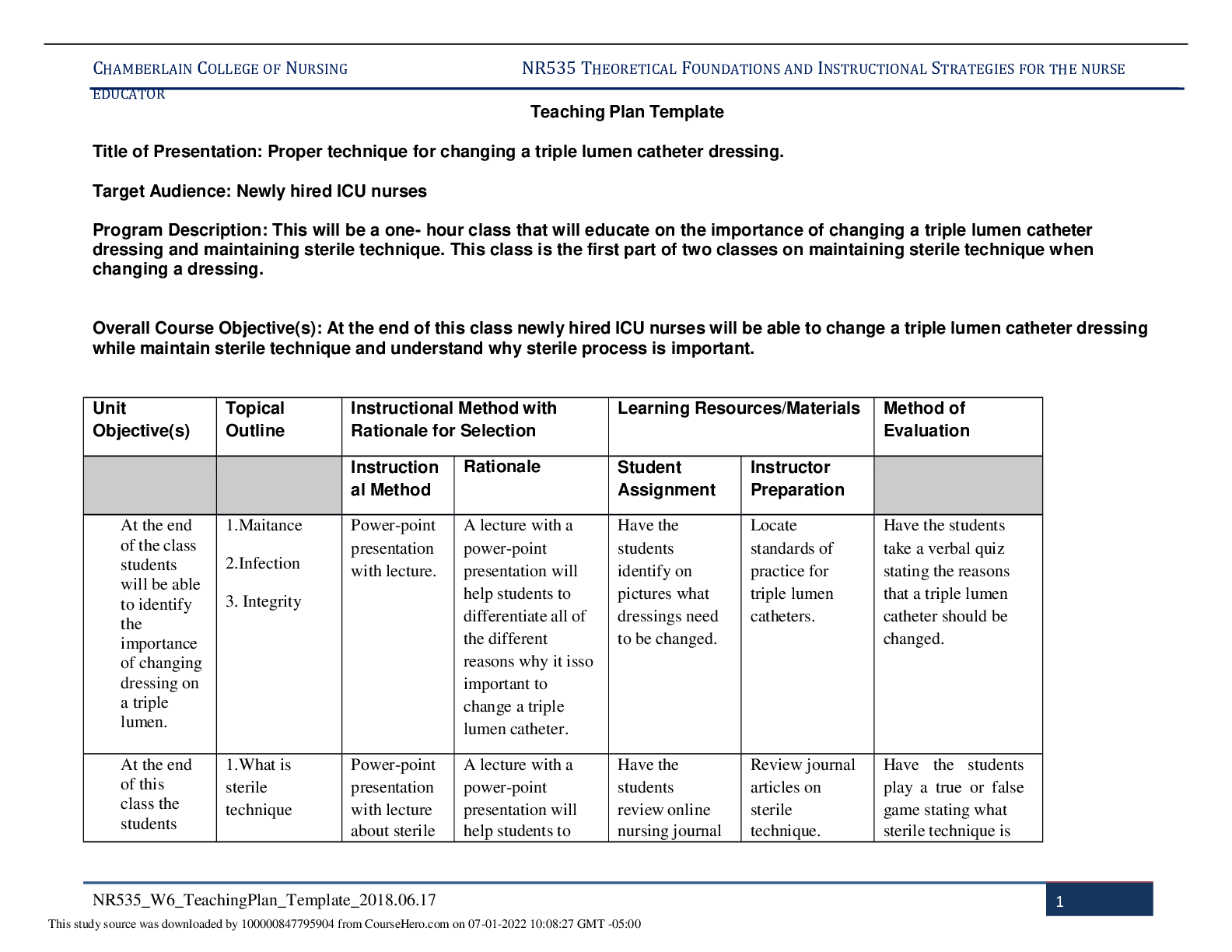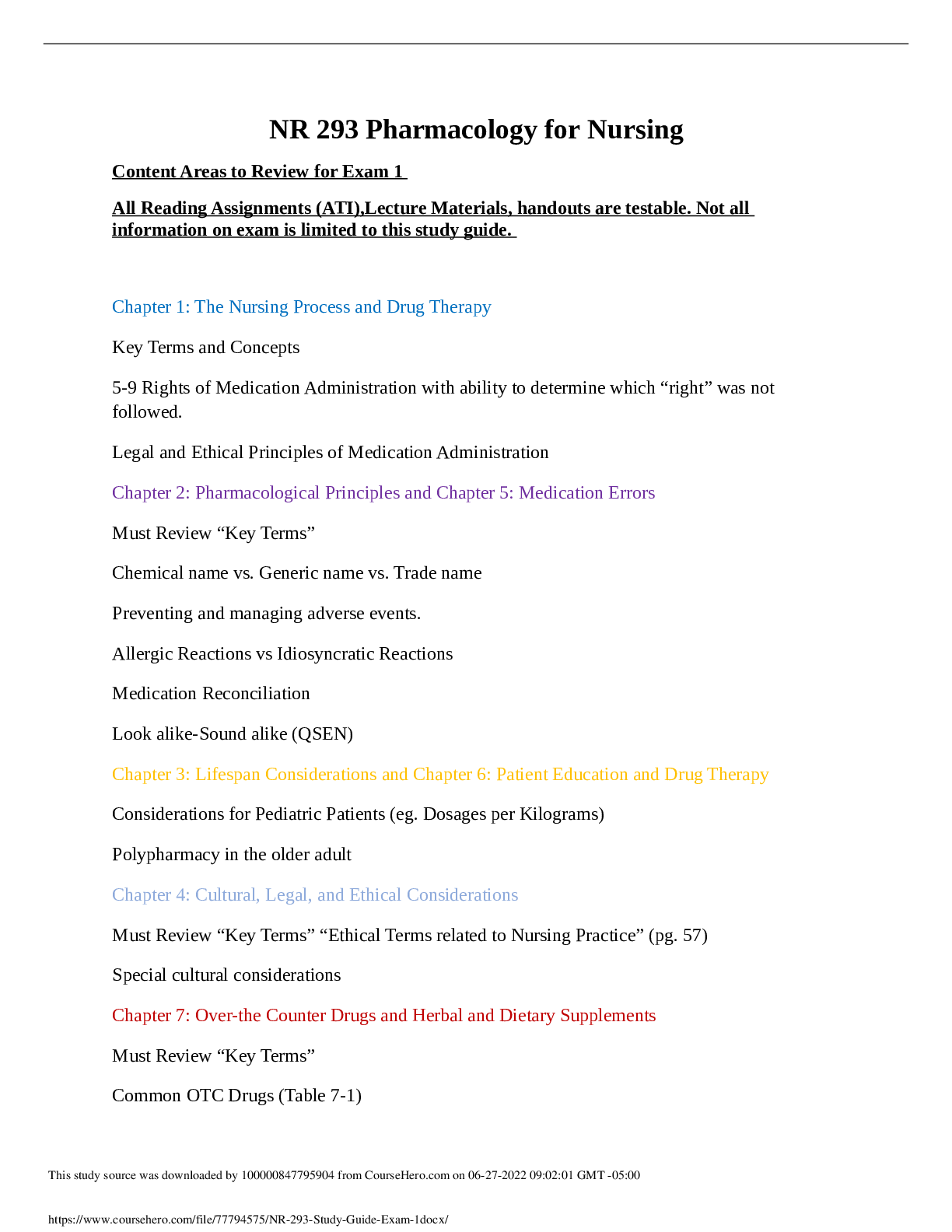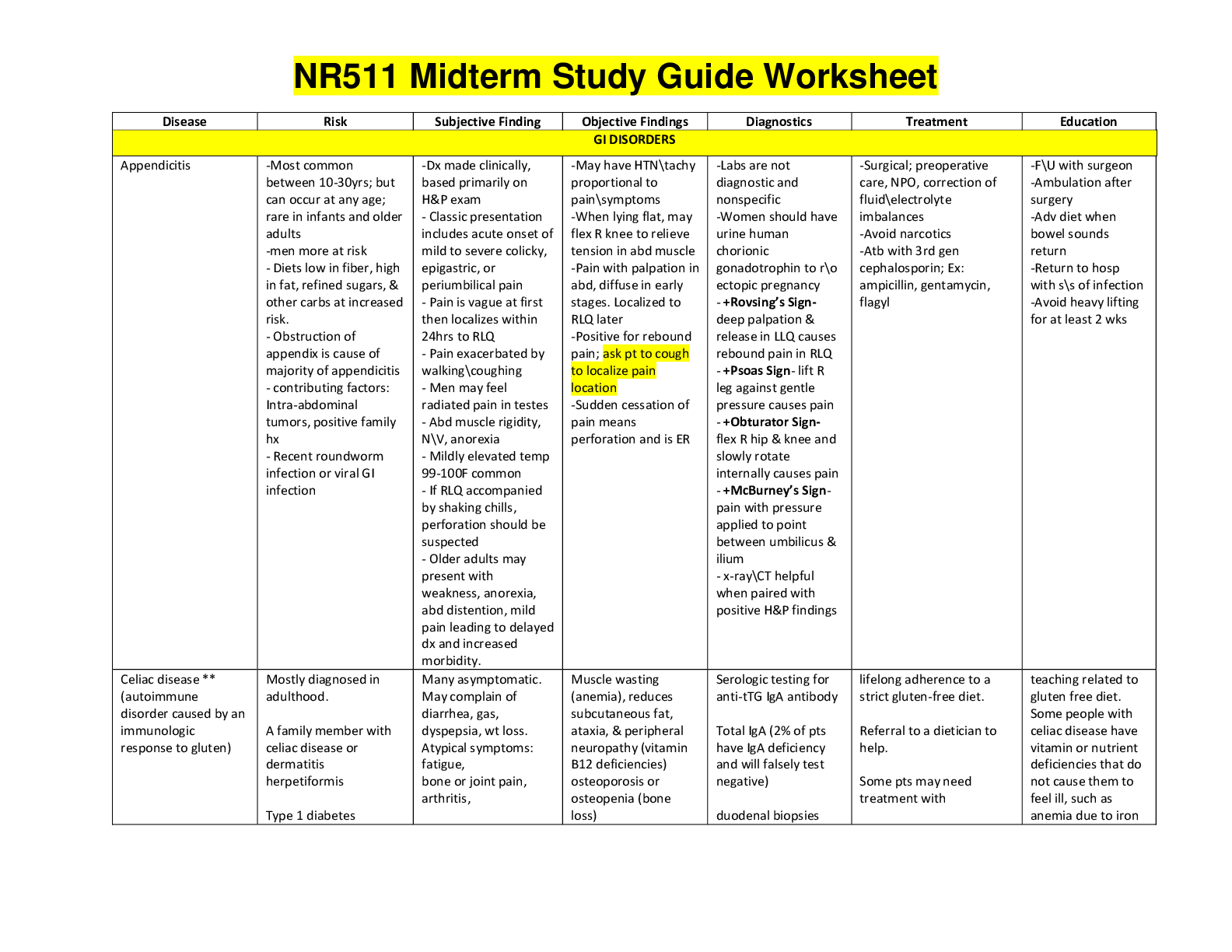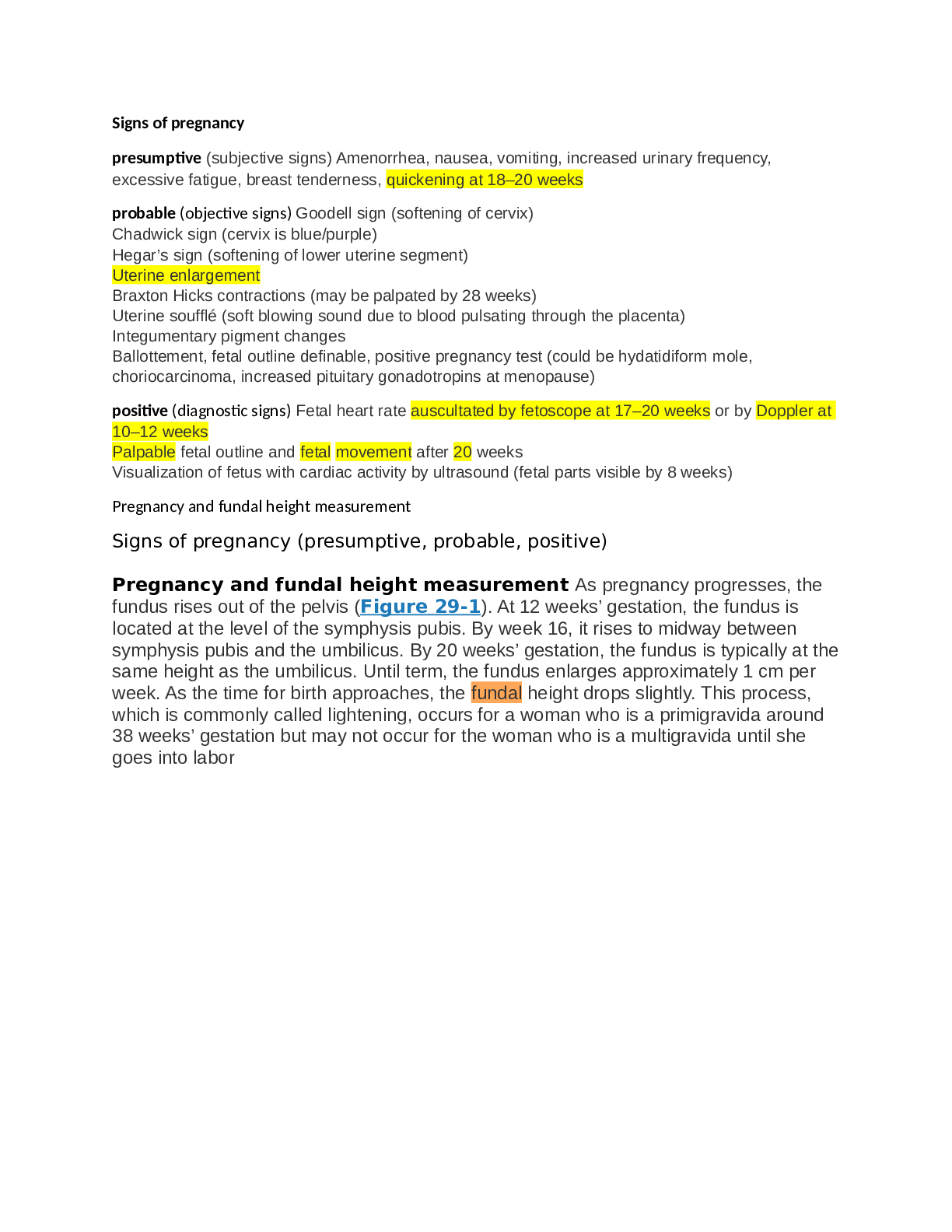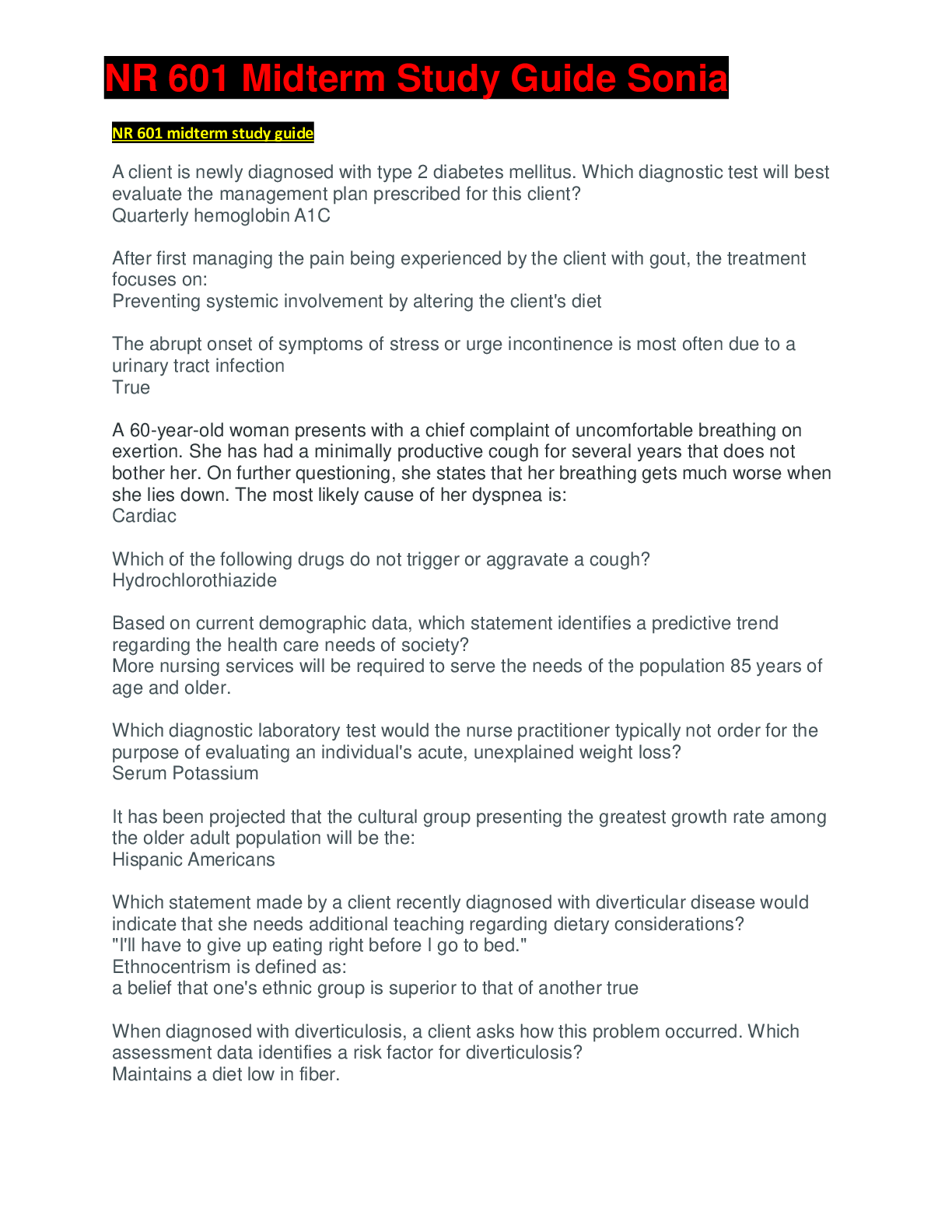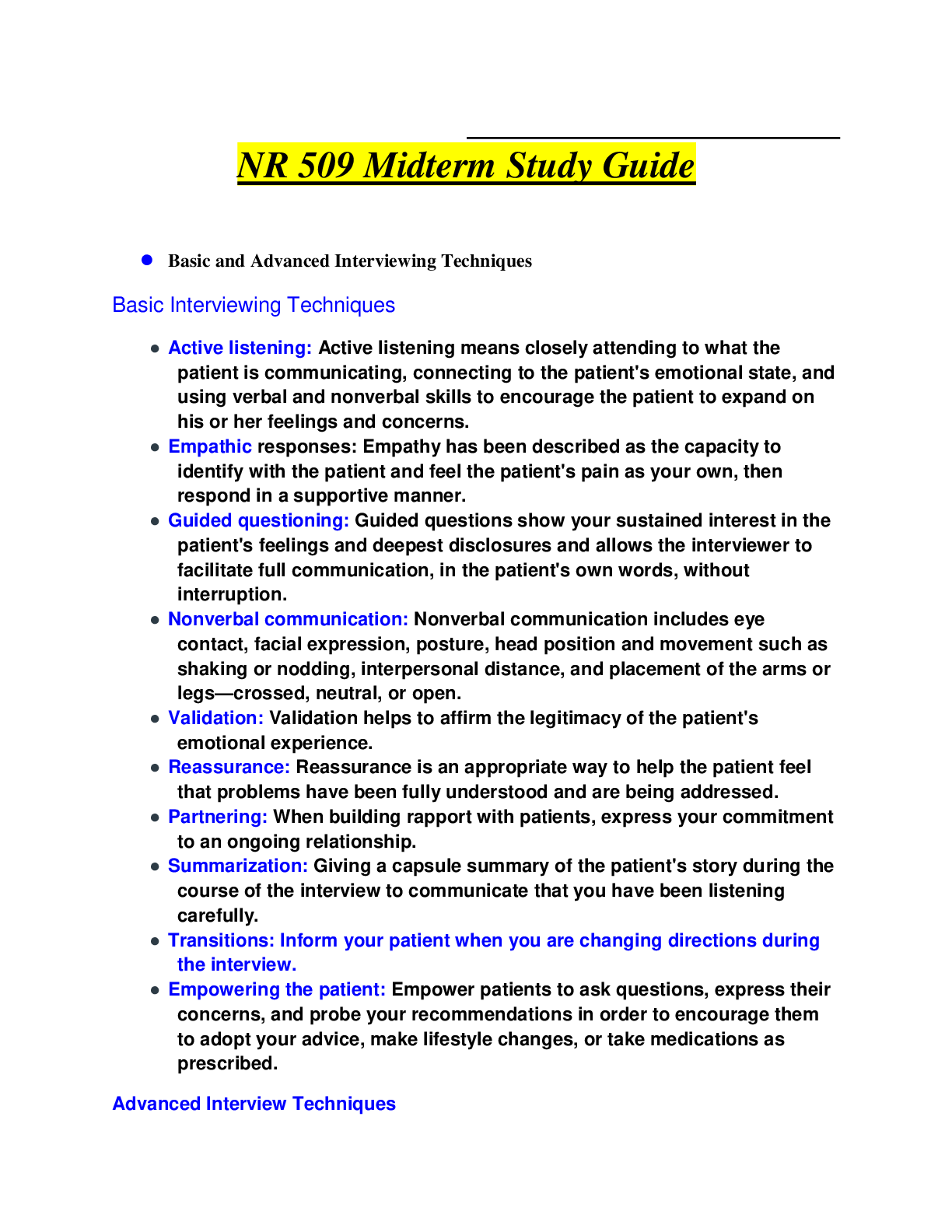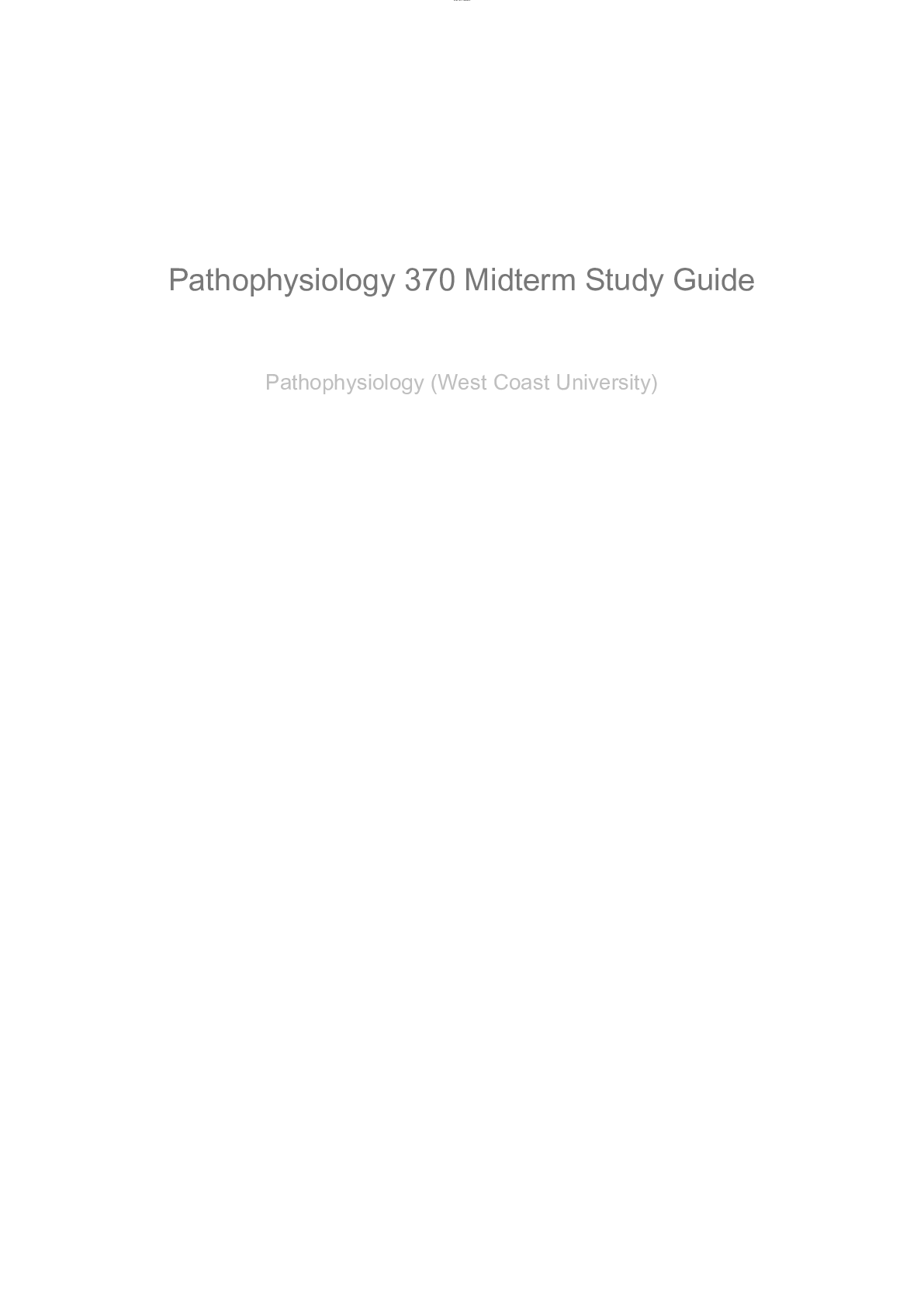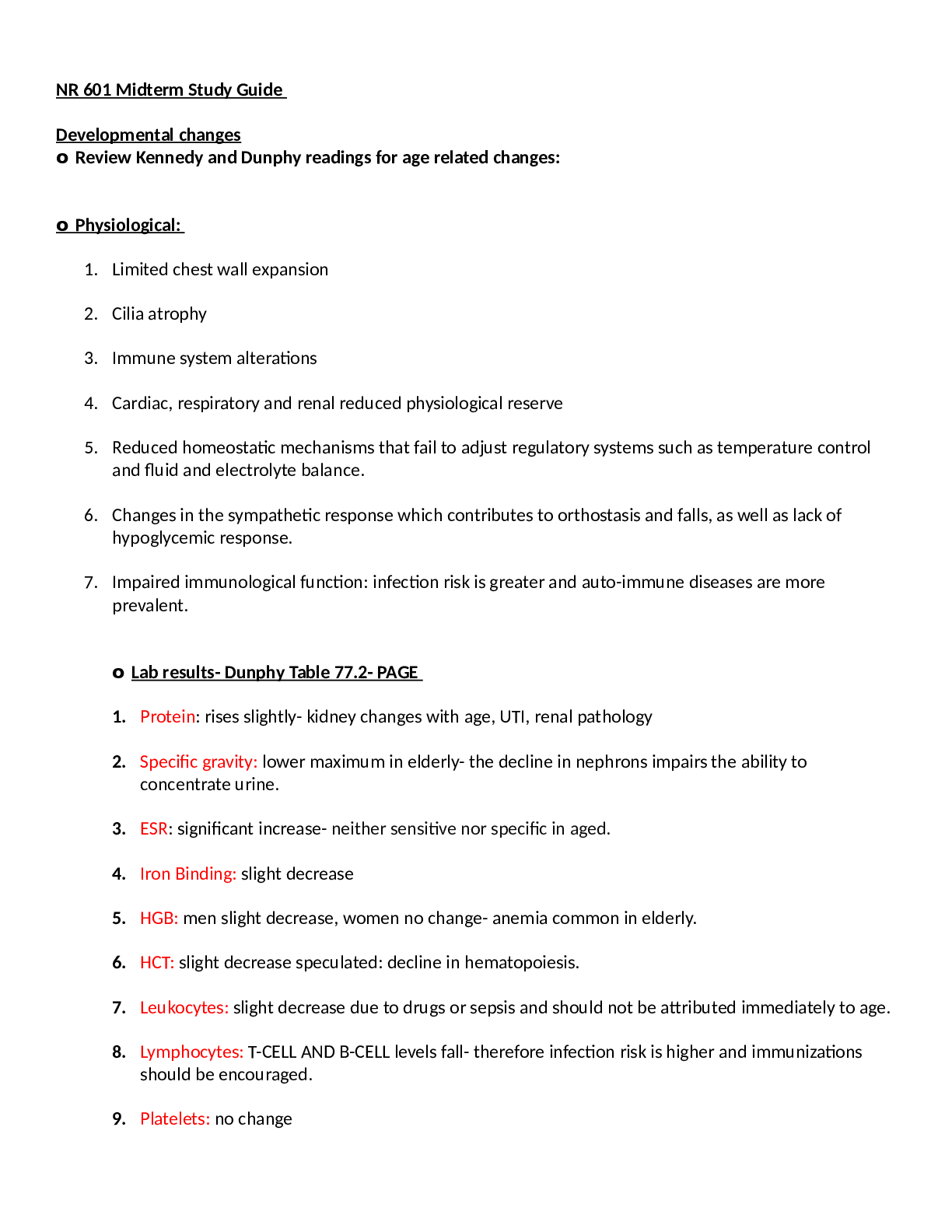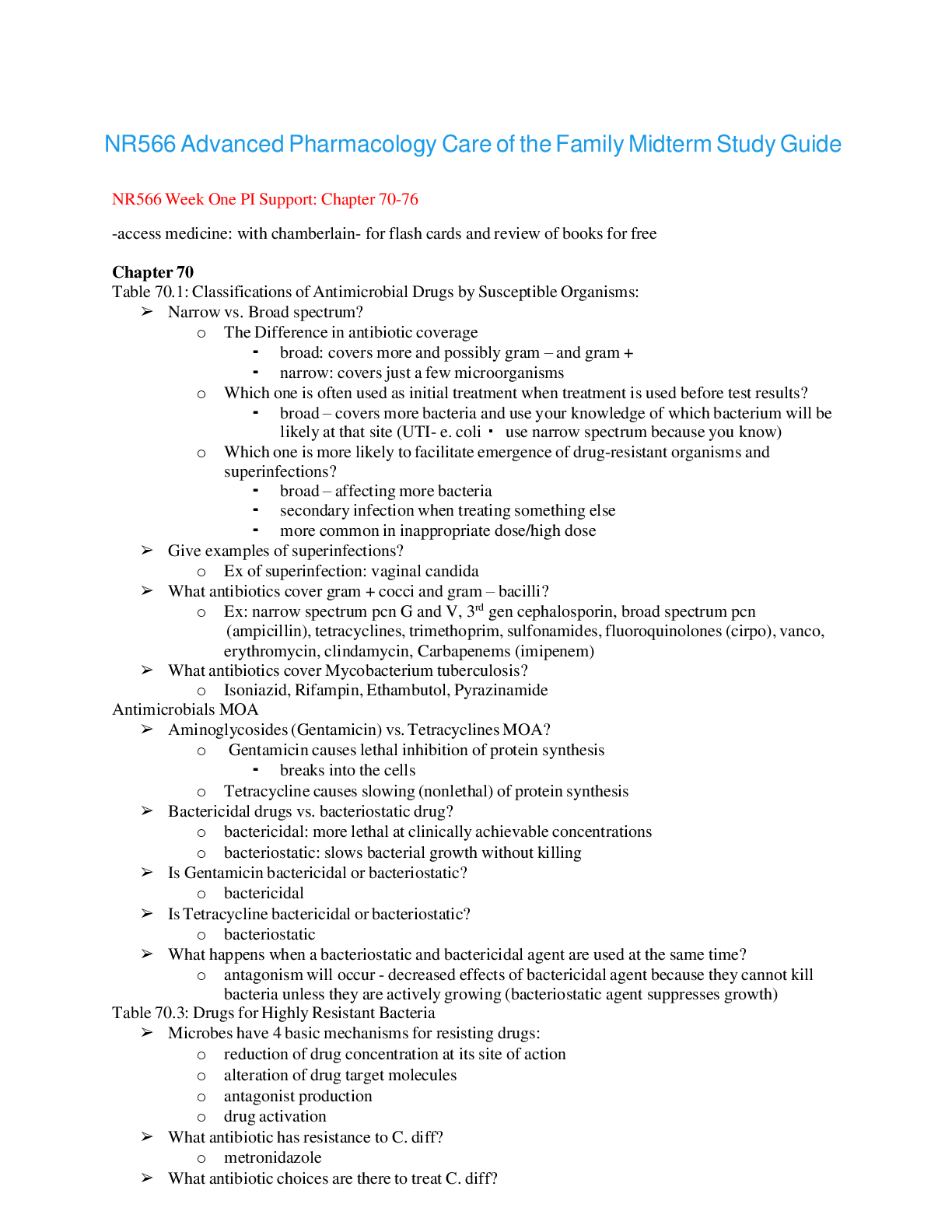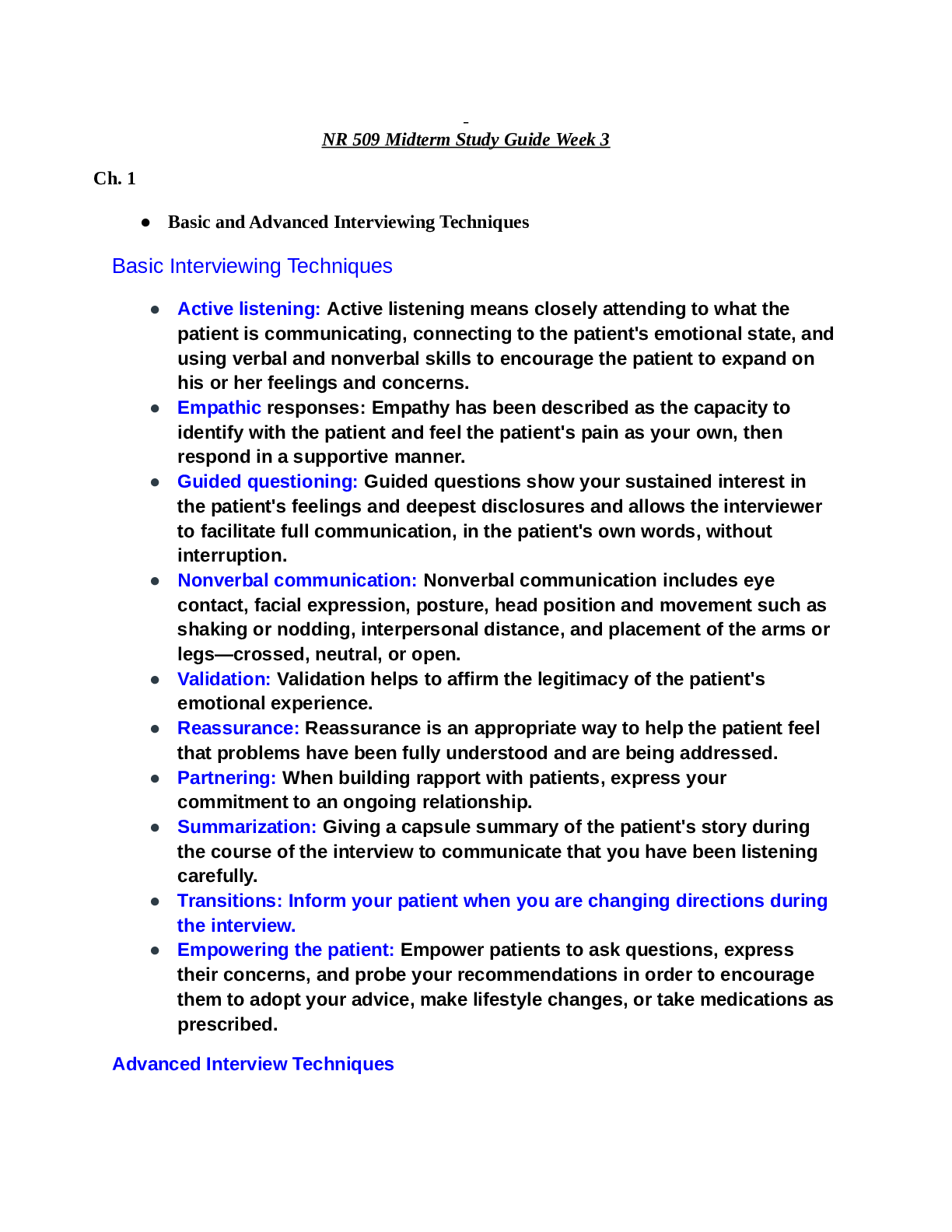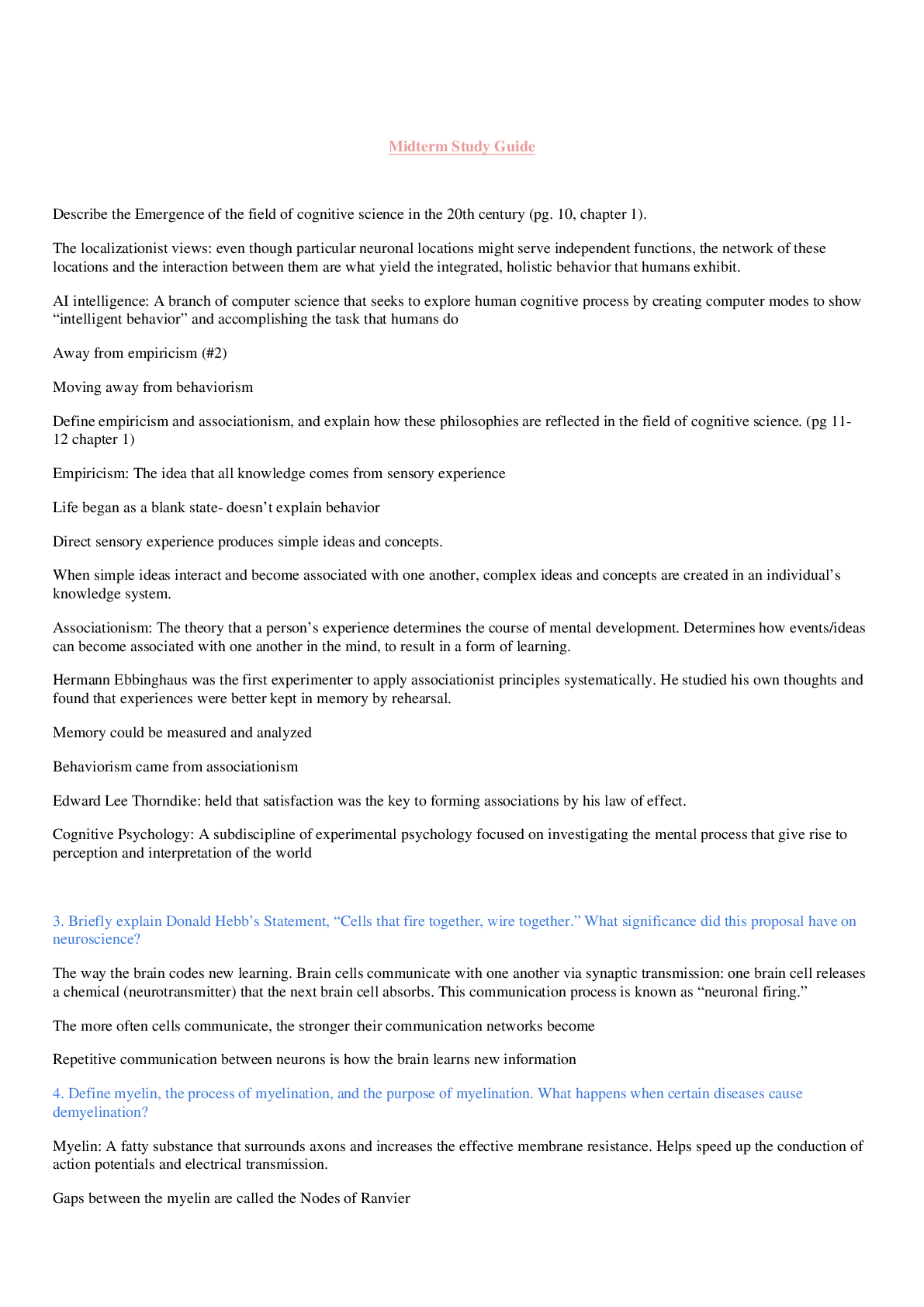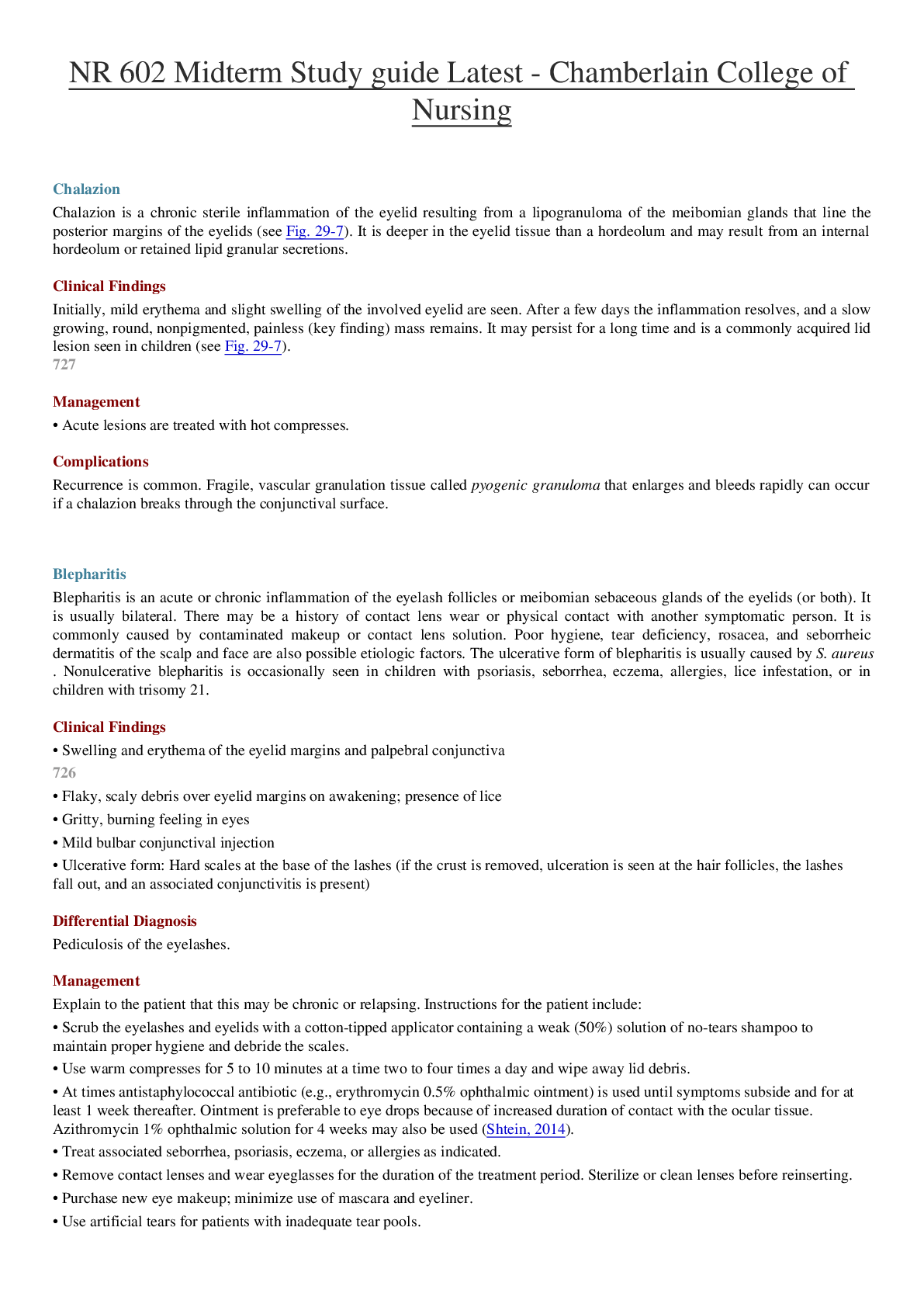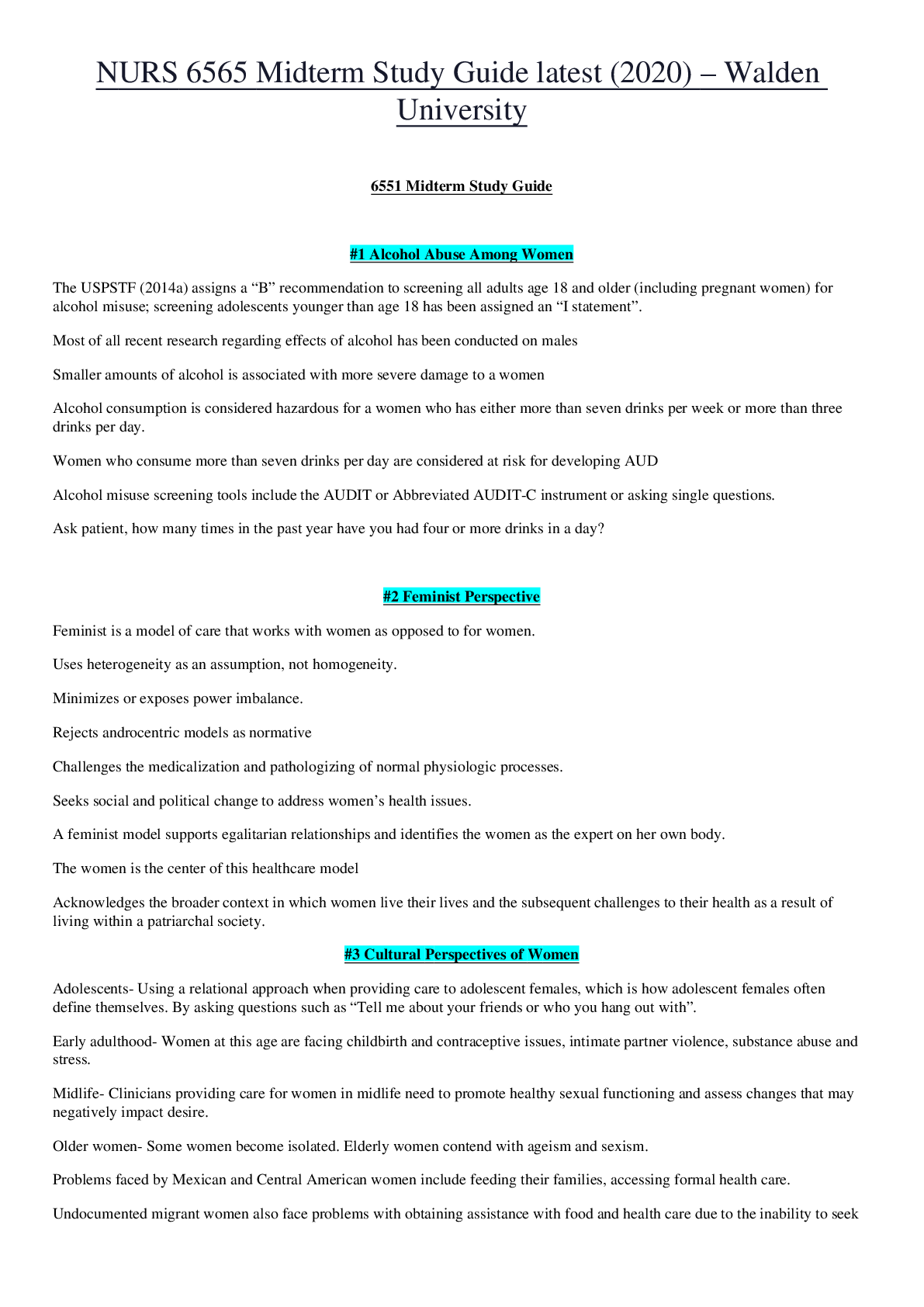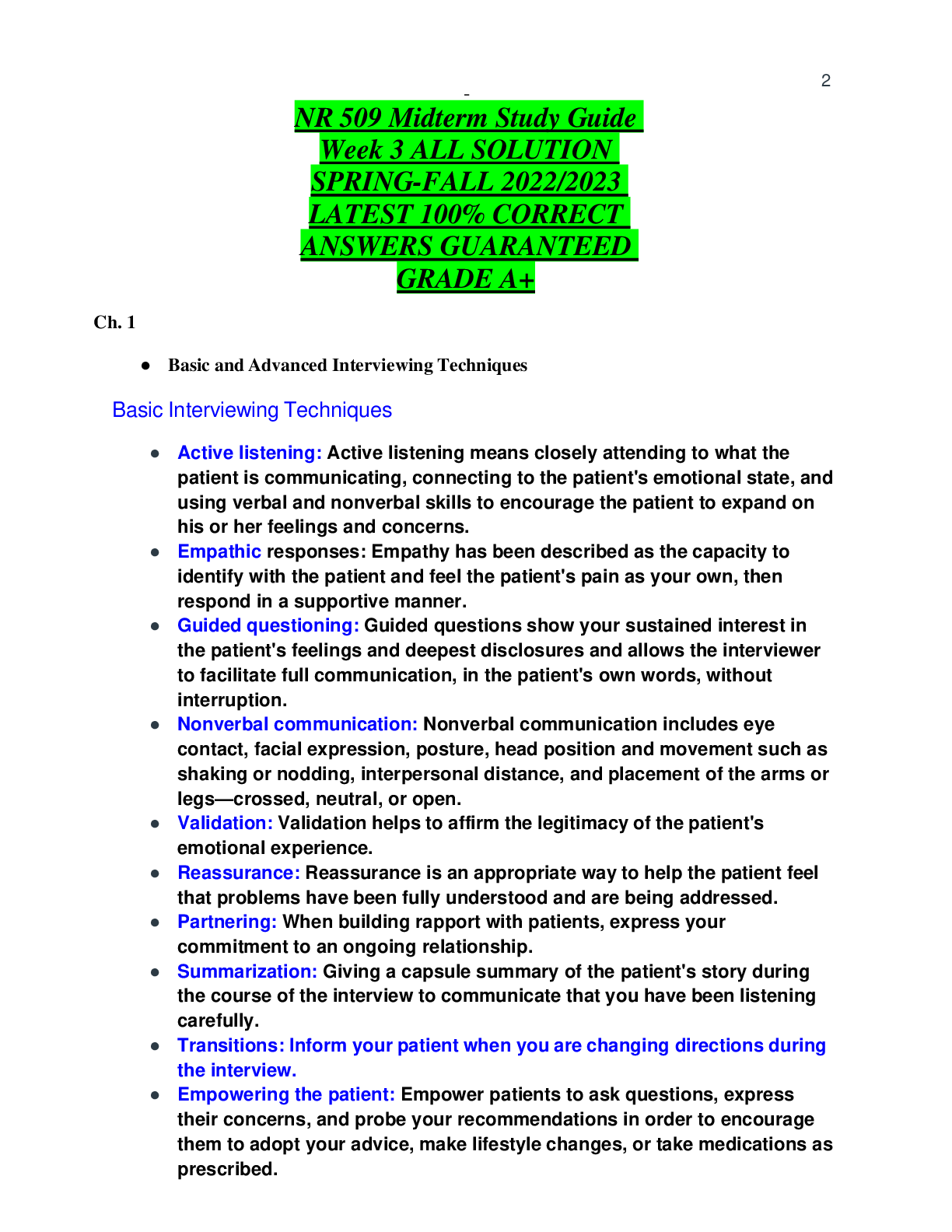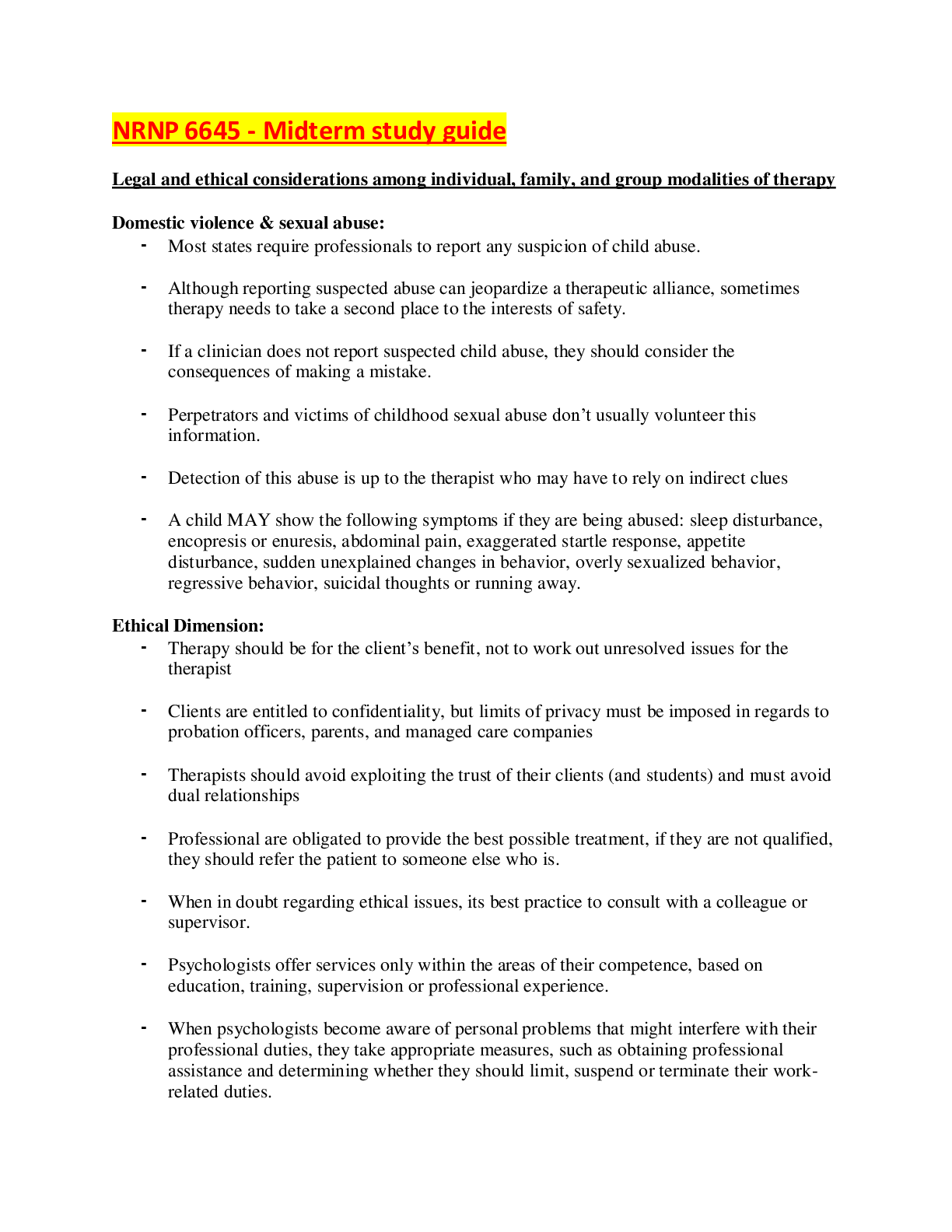*NURSING > STUDY GUIDE > NR 599 MIDTERM STUDY GUIDE COMPLETED (Computer Science, Electronic health record) | GRADED A. | Scor (All)
NR 599 MIDTERM STUDY GUIDE COMPLETED (Computer Science, Electronic health record) | GRADED A. | Score 100 out of 100.
Document Content and Description Below
· Midterm Study guide NR 599 Informatics General principles of Nursing Informatics Nursing informatics is the specialty that integrates nursing science with multiple information management and anal... ytical sciences to identify, define, manage, and communicate data, information, knowledge, and wisdom in nursing practice. One of the most frequently quoted and widely accepted definitions of nursing informatics is that it is a combination of nursing science, information science and computer science · Knowledge • All nurses have the opportunity to be involved in the formal dissemination of knowledge via their participation in professional conferences either as presenters or attendees. • All nurses, regardless of the practice arena, must use informatics and technology to inform and support that practice. · Wisdom • Wisdom is the application of knowledge to an appropriate situation. • In the practice of nursing science, we expect action and/or actions directed by wisdom. • Wisdom uses knowledge and experience to heighten common sense and insight to exercise sound judgment in practical matters. It is developed through knowledge, experience, insight and reflection. · Scientific Underpinning The scientific underpinnings of practice provide the basis of knowledge for advanced nursing practice. These scientific underpinnings include sciences such as biology, physiology, psychology, ethics, and nursing. · The Foundation of Knowledge Model According to Mastrain and McGonigle (2009), one of the most prominent models associated with nursing informatics is the Foundation of Knowledge model. This theory involves integrating four main kinds of knowledge, which are: knowledge acquisition, knowledge dissemination, knowledge generation and knowledge processing. Knowledge acquisition: application of knowledge acquired through education, research, and practice to provide services and interventions to patients to maintain, enhance, or restore their health, and to acquire, process, generate, and dis- seminate nursing knowledge to advance the nursing profession. Knowledge Dissemination: Disturbing and sharing of knowledge learned Knowledge Generation: Creating new knowledge by changing and evolving knowledge based on your experience, education and input from others Knowledge Processing: The activity or process of gathering, collecting or perceiving, analyzing, saving and transmitting knowledge The Foundation of Knowledge model specifically prompts nurses to extend their theoretical and metaphorical knowledge into practical, holistic determinations based on a variety of factors and contexts. Because competencies in informatics include but are not limited to information literacy, computer literacy, and the ability to use strategies and system applications to manage data, knowledge, and information, the ability of nursing students to use computer-mediated communication skills is essential to their success in the nursing field and as a means to improve patient safety. • Organizing conceptual framework for text • Helps to explain the ties between nursing science and informatics and knowledge • Informatics is viewed as a tool for founding knowledge · Computer science · Computer science is introduced through a focus on computers and the hardware and software that make up these evolving systems; computer science is one of the building blocks of nursing informatics. Computer science offers extremely valuable tools that, if used skillfully, can facilitate the acquisition and manipulation of data and information by nurses, who can then synthesize these into an evolving knowledge and wisdom base. Data storage, management, retrieval, and processing. · Cognitive science Interdisciplinary field that studies the mind, intelligence, and behavior from an information processing perspective. A field that involves both cognitive informatics and artificial intelligence. The science of understanding what information is housed in and processed by the brain (Cognitive informatics) · Information science the science of information studying the application and usage of information and knowledge in organizations and the interfacing or interaction between people, organizations and information systems. Integrates features from cognitive science, communication science, computer science, library science and social sciences · Informatics Competencies Have been developed to encompass all levels of practice and ensure that entry- level nurses are ready to enter the more technologically advanced field of nursing. And establish advanced competencies for specialty practice. These competencies may be used to determine the educational needs of current staff members · Information literacy Ability to recognize when info is needed as well as the skills to evaluate and use needed info effectively. this nurse can recognize significant, relevant research and know how to apply it to practice. ability to recognize when information is needed as well as the skills to find, evaluate, and use needed information effectively · Health literacy degree to which individuals can obtain, process, and understand basic health information and services needed to make appropriate health decisions · Meaningful Use use of health information technology to collect specific data with the intent to improve care, engage patients, improve population health, and ensure the privacy and security · Patient-centered Information Systems supports the use and documentation of nursing activities -provides tools for managing and delivery of nursing care -two goals: nursing functions and nursing practice Clinical Decision support systems A computer-based program designed to assist clinicians in making clinical decisions by filtering or integrating vast amounts of information and providing suggestions for clinical intervention. · Electronic Medical Records legal record created in hospitals and ambulatory environments that is the source of data for the EHR -long referred to as single episode treatment -comprised of structured and unstructured data · Human-Technology Interface The hardware and software through which the user interacts with any technology (e.g., computers, patient monitors, telephone, etc.). · Health Information Technology Management and processing of information with the assistance of computers. Computers and IT provide tools that aid data collection and the analysis associated with research to support the overall work of nurses. · Alarm fatigue You get so many alerts that you get numb to them and begin ignoring them · Digital natives Not computer smart, unable to navigate through computers easily. Lack of computer skills. · Information Literacy Competency Standards for Nursing Developed by the TIGER initiative. Three components identified: (1) information literacy, (2) computer literacy, and (3) clinical information management 1. Information literacy a. Ability to identify when information is needed as well as the skills to find, evaluate, and effectively use the same b. Evaluation of online resources for quality c. Able to search literature databases effectively 2. Computer literacy a. Basic familiarity with computer uses and common applications b. Ability to navigate hyperlinks c. Able to set up and use a database 3. Clinical information management a. Uses clinical decision making (CDS) and system safeguards to protect patients and protected health information (PHI) b. Able to request and evaluate reports for the purpose of informed decision making c. Participate in the selection, design, and evaluation of clinical information systems and patient-care technologies d. Uses available technologies to appropriately and effectively communicate · HITECH Act push for more technology to be used especially for education · TIGER-based Nursing Informatics Competencies Model The work of the Technology Informatics Guiding Education Reform team. This team of nursing leaders developed a vision for utilizing information technology to transform nursing practice. Pillars of the TIGER vision include: management and leadership, education, communication and collaboration, informatics design, information technology, policy, and culture. WEEK ONE READING/KEY POINTS McGonigle, D. & Mastrian, K. (2018). ● Chapter 1 ○ Nursing informatics: specialty that integrates nursing science, computer science, cognitive science, and information science ○ For information to be valuable & quality it must be: ■ Accessible & Utility: right user obtain right information at the right time in the right format ■ Accurate: ■ Timely: available when needed for the right purpose at the right time ■ Complete: contains all necessary essential data ■ Cost-effective ■ Flexible: information may be used for a variety or purposes ■ Reliable: authoritative or credible source ■ Relevant: subjective descriptor that has relevant information that is useful ■ Simple ■ Verifiable ■ Transparency: allows user to apply their intellect to accomplish tasks while tools housing the information disappears into the background ■ Secure ■ Reproducibility: ability to produce the same information again ● Chapter 2 ○ Data: raw facts ○ Information: processed data that has meaning ○ Data integrity: whole, complete, correct, and consistent data ○ Dirty data: database that contains errors such as duplicate, incomplete, or outdated records ○ Information science: study of information science-- concerned with input, processing, output, and feedback of data and information through technology integration with a focus on comprehending the perspective of the stakeholders involved and then applying IT as needed. ■ Systemically based-- deals with big picture, opposed to individual pieces of technology ■ Integrates communication science, computer science, cognitive science, library science, and social science ■ Links people and technology ■ Machines (inorganic ISs) Humans (organic ISs) ■ Focuses on why and how technology can be put to best use to serve the information flow within an organization ○ Information systems: handle the needs of the entire organization (communication, tracking, and research) ○ Input: collecting and acquiring raw data ■ Keyboards, touch screen, mice, light pens, automatic scanners ○ Processing: retrieval, analysis, synthesis of data-- transforms data into useful information and outputs ■ Storing for future use, making calculations, comparing data ○ Output: dissemination-- produces helpful information ■ Reports, documents, summaries, alerts, outcomes ● Chapter 3 ○ Motherboard: central nervous system of the computer-- facilitates communication among all components of the computer ○ Hard disk: permanent data storage area that holds gigabytes of data, information, documents even when the computer is turned off. Backing up important files are important because disk drives are not infallible ○ Random-access memory: temporary storage that allows the processor to access program codes and data while working on a task--the contents of RAM are lost once the system is rebooted or shuts off ○ Software: application programs ■ OS software ● Most important software on any computer ● Very first program to load on computer start-up and is fundamental for the operation of all other software and the computer hardware ● Allows user to multitask with ease ● Described in 6 basic processes: Memory, device, processor, and storage management, application and user interface ■ Productivity software ● Provide all the basic programs that a user needs to do their work (word, spreadsheet, email, etc) ■ Creativity software ● Allows user to draw, paint, render, record music and sound, and incorporate multimedia in professional aesthetic ways to share and convey information and knowledge ■ Communication software ● Allows user to share, dialogue, and network with other users via exchange of email or instant message ○ Cloud computing: web-browser based login-accessible data, software, and hardware that you can access and use ■ Public cloud: owned and operated by companies offering public access to computing resources ■ Private cloud: operated for a single organization with the infrastructure being managed internally or outsourced to a third party ● Chapter 4 ○ Cognitive science: fourth of four basic building blocks used to understand informatics-- studies the mind, intelligence, and behavior from an information-processing perspective ○ Connectionism: component of cognitive science that uses computer modeling through artificial neural networks to explain human intellectual abilities ■ Neural network: interconnected simple processing device of the brain and nervous system that consists of a considerable amount of elements or units linked together in a pattern of connections ○ Sources of knowledge ■ Empiricism: knowledge derived from experiences or senses ■ Rationalism: knowledge derived from reason ■ Instinct, reason, intuition ○ Epistemology: the study of the nature and origin of knowledge ○ Wisdom: knowing when and how to apply knowledge (knowledge is understanding information in a way that it can be made useful) ○ Cognitive informatics: field of study that bridges the gap in understanding how information is processed in the mind and in the computer ○ AI: field that deals with the conception, development, and implementation of informatics tools based on intelligent technologies-- uses cognitive science and computer science to replicate and generate human intelligence ● Chapter 6 ○ Nursing informatics: specialty that integrates nursing science with multiple information and analytical sciences to identify, define, manage, and communicate data, information, knowledge and wisdom in nursing practice ■ NI supports nurses, consumers, patients, the interprofessional healthcare team and all other stakeholders in their decision making in all roles and settings to achieve desired outcomes ● Tools to achieve this may include EHR, barcode med admin programs, patient monitoring devices, and telehealth tools ○ DIKW paradigm: data, information, knowledge, and wisdom ■ Also known as the conceptual framework ● Data: discrete facts, describe the patient or their environment-- ex: medical dx (CHF), living status (alone) ● Information: data + meaning, answers questions such as who, what, where, when-- ex: (CHF, unspecified) (78 yo living alone) ● Knowledge: information synthesized so that relations and interactions are defined and formalized, answers questions of why or how (CHF, unspecified, living alone, 70 yo, d/c from hospital on blood thinners- indicated high risk for ADR) ● Wisdom: use of knowledge to manage and solve human problems-- ex: nurse prioritizes patient above others ○ International classification of nursing practice:initiative to standardize the language of nursing practice ■ Better communication among nurses and providers, increased visibility of nursing interventions, improved patient care, enhanced data collection to evaluate nursing care outcomes, greater adherence to standards of care, and facilitation of assessment of nursing competency ○ Knowledge worker: advanced formal education and is able to apply theoretical and analytical knowledge ■ Innovators that work to produce the foundation for organizational sustainability and growth ■ Nurses transition from knowledge users to knowledge builders when they examine clinical data and trends across groups of patients WEEK TWO READING/KEY POINTS McGonigle, D. & Mastrian, K. (2018). ● Chapter 7 ○ Advocate/policy developer ■ A nurse informatics specialist who is key to developing the infrastructure of health policy. Policy development on the local, national, and international levels is an integral part of this role. ○ Certification ■ System for validating that a nurse possesses certain skills and knowledge or is competent to complete a task. Competence and skill level are determined by or based on an external review, assessment, examination, or education. ○ Consultant ■ A person hired to provide expert advice, opinions, and recommendations based on his or her area of expertise. ○ Data ■ Raw facts that lack meaning. ○ Decision support/outcomes manager ■ Person charged with reviewing the effects of interventions suggested by the computerized decision support system. ○ Educator ■ Sage, leader, and/or guide who assists in the process or practice of learning. ○ Entrepreneur ■ Person who assumes the risks of beginning an enterprise or business and accepts responsibility for organizing and managing the organization. ○ Informatics ■ A field that integrates a specialty’s science, computer science, cognitive science, and information science to manage and communicate data, information, knowledge, and wisdom in a specialty’s practice. ○ Informatics innovator ■ One who makes enhancements or improvements and creative, novel, and inventive solutions in the informatics specialty. ○ Informatics nurse specialist ■ A registered nurse with formal, graduate education in the field of informatics or a related field, who is considered a specialist in the field of nursing informatics. ○ Knowledge worker ■ Those who work with information and generate information and knowledge as a product. ○ Medical informatics ■ A specialty that integrates medical science, computer science, cognitive science, and information science to manage and communicate data, information, knowledge, and wisdom in medical practice. ○ Product developer ■ One who designs, creates, and builds a product ○ Project manager ■ Person responsible for the success of a project, who manages the planning and enactment of the project. ○ Researcher ■ The one who researches ○ TIGER initiative ■ The work of the Technology Informatics Guiding Education Reform team. This team of nursing leaders developed a vision for utilizing information technology to transform nursing practice. ● Chapter 15 ○ Adverse events ■ Any undesirable experiences or outcomes in a patient related to the use of a medical treatment or product. ○ Agency for Healthcare Research and Quality (AHRQ) ■ An agency within the U.S. Department of Health and Human Services that supports health services research initiatives. ○ Bar-code medication administration (BCMA) ■ A system using bar-code technology affixed to the medication ○ Clinical decision support (CDS) ■ A computer-based program designed to assist clinicians in making clinical decisions by filtering or integrating vast amounts of information and providing suggestions for clinical intervention. ○ Computerized physician order entry (CPOE) ■ Clinicians place orders within these systems instead of using traditional handwritten transcription onto paper. ○ Electronic medication administration system (eMAR) ■ A system that uses bar-coding technology in order to submit and fill prescriptions. ○ Failure modes and effects analysis (FMEA) ■ A systematic evaluation of a process to determine how and why it failed to produce the desired results. ○ Government Accountability Office (GAO) ■ The highest audit institution of the federal government that provides auditing, evaluation, and investigative services for the U.S. Congress. ○ High-hazard drugs ■ Drugs known to cause significant adverse side effects when administered inappropriately ○ Human factors engineering ■ Recognizing the limitations of human performance and developing products to overcome these limitations. ○ Just culture ■ An atmosphere of trust ○ Never events ■ Events that should never occur, such as wrong-site surgeries and retained surgical objects. ○ Radio frequency identifier (RFID) ■ An identification chip that stores information for retrieval. ○ Root-cause analysis ■ Similar to failure modes and events analysis; analysis to discover why a process is faulty or produces an undesired result. ○ Safety culture ■ An organizational commitment to patient safety and the prevention of medical errors. ○ Smart pump ■ Machine used to infuse medication that includes dose-checking technology and safeguards ○ Smart rooms ■ Patient rooms that are equipped with technologies to increase patient safety and improve patient care. ○ Systems engineering ■ An approach where technology manufacturers partner with organizations to identify risks to patient safety and promote safe technology integration. ○ Wearable technology ■ The study or practice of inventing, designing, building, or using miniature body-borne computational and sensory devices. McBride, S., & Tietze, M. ● Chapter 2 ○ Advanced practice ■ Designed to improve the science of simulation and share best practice and provide evidence based guidelines. ○ Interprofessional ■ Collaborating and interacting with other healthcare professionals to ensure positive patient outcomes. ● Chapter 24 ○ Competencies ■ Rely primarily on methods that self-report through survey instrumentation methods. Valid and reliable methods to evaluate informatics competencies measurably and objectively within simulation centers are not currently available. ○ electronic health record ■ Creating a significant change in the way clinicians access, read, digest, and use the information within the health record to treat patients. ○ Simulation ■ Simulation-based learning requires learners to actively participate in dynamic experiences as opposed to static, traditional modes of learning. WEEK THREE READING/ KEY POINTS McGonigle, D. & Mastrian, K. ● Chapter 11 ○ Cognitive task analysis ■ Examination of the nature of a task by breaking it down into its component parts and identifying the performers’ thought processes. ○ Cognitive walkthrough ■ Within cognitive walkthrough when evaluators assess a paper mockup, working prototype, or completed interface by observing the steps users are likely to take to use the interface ■ . This analysis helps designers determine how understandable and easy to learn the interface is likely to be for these users and the typical tasks ○ Cognitive work analysis ■ Cognitive work analysis was developed for the analysis of complex, high-technology work domains ■ A complete CWA includes five types of analysis: (1) work domain, (2) control tasks, (3) strategies, (4) social–organizational, and (5) worker competencies ■ Work domain analysis describes the functions of the system and identifies the information that users need to accomplish their task goals ○ Earcons ■ Auditory tones that are combined to represent relationships among data elements, such as the relationship of systolic blood pressure to diastolic blood pressure. ○ Ergonomics ■ describe the physical characteristics of equipment—for example, the optimal fit of a scissors to a human hand. ○ Field study ■ Study in which end users evaluate a prototype in the actual work setting prior to its general release. Also called field test, alpha test, or beta test. ○ Gulf of evaluation ■ The gap between knowing one’s intention (goal) and knowing the effects of one’s actions. ○ Gulf execution ■ The gap between knowing what one wants to have happen (the goal) and knowing what to do to bring it about (the means to achieve the goal). ○ Heuristic evaluation ■ An evaluation in which a small number of evaluators (often experts in relevant fields such as human factors or cognitive engineering) evaluate the degree to which an interface design complies with recognized usability principles (the “heuristics”). ○ human -computer interaction ■ How people use and interact with computers; the study of how people use computers and software applications and the ways that computers influence people. ○ Human factors ■ Recognizing the limitations of human performance and developing products to overcome these limitations. ○ Human tech interaction ■ How users interact with technology. The study of that interaction. ○ Mapping ■ How environmental facts (e.g., the order of light switches or variables in a physiologic monitoring display) are accurately depicted by the information presentation. ○ Situational awareness ■ The ability to detect, integrate, and understand critical information that leads to an overall understanding of a problem or situation. ○ Task analysis ■ Analytic technique that focuses on how a task must be accomplished, including detailed descriptions of task-related activities, task characteristics and complexity, and the environmental conditions required for a person to perform a given task. ○ Usability ■ The ease with which people can use an interface to achieve a particular goal. Issues of human performance during computer interactions for specific tasks within a particular context. ○ Workarounds ■ Ways invented by users to bypass the system to accomplish a task; usually indicate a poor fit of the system ● Chapter 14 (pages 266-269) ○ EHR ■ Computer-based data warehouses or repositories of information regarding the health status of a client, which are replacing the former paper-based medical records; they are the systematic documentation of a client’s health status ○ HITECH ■ Title XIII of the American Recovery and Reinvestment Act, which was enacted in February 2009. Under this act, healthcare organizations can qualify for financial incentives based on the level of meaningful use achieved; the HITECH Act specifically incentivizes health organizations and providers to become “meaningful users.” ○ American Recovery and Reinvestment Act (ARRA) ■ An economic stimulus package enacted in February 2009 that was intended to create jobs and promote investment and consumer spending during the recession. This act has also been referred to as the Stimulus or Recovery Act. There was a push for widespread adoption of health information technology, ○ Meaningful use ■ The American Recovery and Reinvestment Act of 2009 specifies three main components of meaningful use: ● (1) the use of a certified electronic health record (EHR) in a meaningful manner, such as e-prescribing ● (2) the use of certified EHR technology for electronic exchange of health information to improve quality of health care ● (3) the use of certified EHR technology to submit clinical quality and other measures. ○ The criteria for meaningful use will be staged in three steps. ■ Stage 1 (2011–2012) set the baseline for electronic data capture and information sharing. ■ Stage 2 (2013) ■ Stage 3 (expected to be implemented in 2015) will continue to expand on this baseline and be developed through future rulemaking. McBride, S., & Tietze, M. (2018). ● Chapter 1 ○ Health information exchange (HIE) ■ Data translated into actionable information with extensive data management and reporting capability on which providers can manage and improve care ○ Medicare Access and CHIP Reauthorization Act (MACRA) ■ there is significant emphasis on expanding the requirement to capture more structured data, better quality reporting, and better capacity to exchange data using HIEs within and across states and regions ○ Merit-Based Incentive Payment System (MIPS) ■ with a focus on interoperability ○ National Strategy for Quality ■ Improvement in Health Care, several legislative components have been implemented. ○ Patient Protection and Affordable Care Act (ACA) ■ focused on providing all Americans with access to quality and affordable healthcare ○ The third content domain of the NEHI framework: goal to improve patient outcomes ■ Patient safety ■ Population health ■ Quality ● Chapter 8 ○ Agile ■ Agile development is a technique that is a programmer-driven technique that creates a feedback loop with the end users. This technique is based primarily on verbal communication with the end user and does not rely on documentation strategies ○ Alpha testing ■ testing is done using test data or “made-up” data. ○ beta testing ■ gets a step closer to production with a sample of “real” data to test how the system functions and looks for any errors that might arise. ○ big-bang implementation ■ all units or hospitals in a system go live at once ○ command center ■ A 24-hour resource center on site for the first 3 days of each rollout. ○ commercial off-the-shelf products ■ require customization. Customization must be done in-house by a design team, or the design team is contracted through the vendor or a service provider company. This design work requires close alignment with end-user requirements. ○ core implementation team ■ The team is on site the first 24 hours and available by cell or pager for 2 weeks thereafter. ○ cost–benefit analysis ■ Is the cost worth the benefit ○ Evaluation ■ Evaluating how well the product is working ○ Implementation ■ Putting the product into effect ○ integration testing ■ one or more modules or components work together (integrate) and function as designed. ○ project management ■ is an essential tool of the design phase of the SDLC because it is required to keep implementation and development projects on time, in scope, and within budget. ○ rapid application development ■ RAD deploys software tools and analysis and design strategies to speed up development. The goal is to get systems rapidly into the hands of the end user to test and refine the product to meet the end-user requirements ○ request for information ■ is a shorter, less detailed request that surveys what type of products might fit the end user’s needs, ○ request for proposal (RFP) ■ includes detailed specifications and requirements that typically serve as a more binding proposal or offer to accomplish the goals or product needs of the customer ○ return on investment (ROI) ■ electronic information systems and technology in the healthcare setting is an important consideration, but other success factors include improvements in quality, safety, and population health. ○ Scrum ■ is considered by some to be the most popular software development agile framework and is a term used for iteration ○ Sprint ■ is defined by the “scrum master” or the agile team’s facilitator. ○ Superuser ■ Users that have expert technology skills ○ system testing ■ is typically done by the system analyst to make sure the system functions as the designer understood it to be developed. ○ systems development life cycle (SDLC) ■ is a standardized approach used to develop and implement an information technology (IT). ■ This framework is often used across industries to structure best practices for IT development and deployment. ■ SDLC is a phased approach used to analyze and design information systems that is broken into distinct phases ○ unit testing ■ is one specific component or module that performs a specific task ○ Waterfall ■ approach to development occurs in a cascade fashion with analysts and users proceeding in a sequenced manner from one phase to the next. The phases are linear in approach and do not cycle back around to inform the former stage. ● Chapter 11 ○ Business associate agreements (BAA) ■ BAA is in place with each of their partners to maintain security and overall HIPAA compliance. ○ Centralized model ■ HIE data sharing is protected through data-sharing agreements, and data are stored for use by organizations through the data repository. This approach typically fosters the use of data within the community or region in a collaborative manner, supporting initiatives to improve quality, patient safety, population health, and care coordination ○ Community Health Information Networks (CHINs) ■ Commercially driven endeavors with intents that were similar to those of our current HIEs. They focused on exchanging data across a community; however, these initiatives lacked payer and community stakeholders. CHINs were primarily transaction-based and provider-based data exchanges that did not store data within a centralized repository. ○ Data Use and Reciprocal Agreement (DURSA) ■ Serves as the main legal framework for eHEX participants continues to ensure that privacy protections are important at the eHEX and with its participants ○ Decentralized model or Federated model ■ An approach maintains the control of the source data at the originating organization, and data are cached and transmitted to the provider as needed at the point of care ○ Health information exchange (HIE) ■ health information follows the patient wherever and whenever they seek care, in a private and secure manner so that teams of doctors, nurses and care managers can provide coordinated, effective, and efficient care ○ Interoperability ■ the ability of computer systems or software to exchange and make use of information ○ Master patient index ■ Identify unique patients within a delivery system maintaining disparate information systems or across institutions within regions. An MPI is an important element for effective management of patient care across institutions ○ Regional Health Information Organizations (RHIOs) ■ Were the next concept to arise and were related to the exchange of regional data. RHIOs were defined as “neutral, third-party organizations that facilitate information exchange between providers within a geographical area to achieve a more effective and efficient healthcare WEEK FOUR READING/ KEY POINTS McGonigle, D. & Mastrian, K. ● Chapter 16 ○ Blogs ■ Interactive, online weblogs. Typically a combination of what is happening on the Web as well as what is happening in the blogger’s or creator’s life. ○ Digital divide ■ The gap between those who have and those who do not have access to online information. ○ Domain name ■ A series of alphanumeric characters that forms part of the Internet address or URL ○ E-brochure ■ Electronic brochure. Patient education material that is typically tied to an agency website and may include such information as descriptions of diseases and their management, medication information, or where to get assistance with a healthcare issue. ○ E-health ■ Healthcare initiatives and practice supported by electronic or digital media. The most typical use is for patient and family education where information is communicated electronically. ○ eHealth Initiative ■ Initiative developed to address the growing need for managing health information and to promote technology ○ Empowerment ■ Promotion of self-actualization; achievement of power or control over one’s own life. ○ Gray gap ■ A term used to reflect the age disparities in computer connectivity; there are fewer persons older than age 65 who use computer technology than members of younger age groups. ○ HONcode ■ One of the two most common symbols that power users look for to identify trusted health sites. ○ Interactive technologies ■ Technologies that promote or support user communication with other persons ○ Know–do gap ■ Situation that exists because solutions to global health problems are available but are not implemented in a timely fashion because of the lack of access to important health information. ○ Static medium ■ Something that cannot be updated ○ Trust-e ■ One of the two most common symbols that power users look for to identify trusted health sites. ○ Voice recognition ■ A type of software that allows the user to input data or to navigate the Web using voice commands. ○ Web quests ■ Searches of the World Wide Web for information. ○ Weblog ■ A website that contains the contributions of single or multiple users about a particular topic or issue. ● Chapter 17 ○ Agency for Toxic Substances and Disease Registry (ATSDR) ■ A federal agency that acts as a repository for research and data regarding hazardous materials that serves the public by using the best science ○ Behavioral Risk Factor Surveillance System ■ An assessment system initially designed to collect information on the movement of mentally impaired persons from state-operated facilities into community settings. ○ Bioterrorism ■ The use of pathogens or other potentially harmful biological agents to sicken or kill members of a targeted population. ○ Centers for Disease Control and Prevention (CDC) ■ An agency of the U.S. Department of Health and Human Services that works to protect public health and safety related to disease control and prevention. ○ Community risk assessment (CRA) ■ A comprehensive examination of a community to identify factors that potentially affect the health of the members of that community. ○ Crowdsourcing ■ Information generated by individuals on social media. ○ Epidemiology ■ The field of study identifying things that come upon the people. Incidence, prevalence, and control of disease. ○ National Center for Public Health Informatics (NCPHI) ■ Center created in 2005 by the Centers for Disease Control and Prevention to provide leadership in the field of public health informatics. ○ National health information network ■ An agency of the U.S. Department of Health and Human Services charged with the development of a safe, secure, interoperable health information infrastructure. ○ National Health and Nutrition Examination Survey ■ A survey sponsored by the Centers for Disease Control and Prevention that combines both questionnaires and physical examinations to collect data on the health and nutritional status of adults and children in the United States. ○ Public health ■ The science of protecting the well-being of communities and the population through education, research, intervention, and prevention. ○ Public health informatics ■ An aspect of informatics focused on the promotion of health and disease prevention in populations and communities. ○ Public health interventions ■ Actions taken to promote and secure the well-being of a population or a community. ○ Regional health information exchanges ■ A regional network of healthcare organizations and providers who exchange information related to the health of the population. ○ Risk assessment ■ Determination of risk or danger, such as assessing for risk factors related to heart disease. ○ Suicide Prevention Community Assessment Tool ■ Risk assessment method that addresses general community information, prevention networks, and the demographics of the target population as well as community assets and risk factors. ○ Surveillance ■ The act of watching for trends in health-related data for early detection of health threats. ○ Surveillance data systems ■ A networked computer system designed to use health-related data trends to predict the probability of an outbreak of a contagious or infectious disease or to detect morbidity and mortality trends ○ Syndromic surveillance ■ A specialized system of data collection that seeks to detect trends in the incidence and severity of a specific disease or health-related syndrome and plan the public health response. ○ Youth Risk Behavior Surveillance System ■ An epidemiologic survey conducted by the Centers for Disease Control and Protection to identify and track the most common health risk behaviors that lead to illnesses and mortality among youth. ● Chapter 21 ○ American Library Association ■ A U.S.-based organization that promotes libraries and library education internationally. ○ Cumulative Index to Nursing and Allied Health Literature ■ A comprehensive nursing and allied health literature database. ○ Educational Resources Information Center ■ A comprehensive educational resources database. An international database of educational literature. ○ Fair use ■ Doctrine that permits the limited use of original works without the copyright holder’s permission ○ Foundation of Knowledge model ■ Model proposing that humans are organic information systems constantly acquiring, processing, generating, and disseminating information or knowledge in both their professional and personal lives. ○ Information literacy ■ Recognizing when information is needed and having the ability to locate, evaluate, and effectively use the needed information. McBride, S., & Tietze, M. ● Chapter 4 ○ accountable care organizations (ACA) ■ that were embedded in the ACA, required more robust technological infrastructure and subsequent policy documents to fully develop their potential ○ Beacon project ■ designed to demonstrate the kinds of clinical quality improvements that are possible in communities with more robust EHR adoption. ○ health information exchange ■ Continue to lack plug-and-play functionality that would lower implementation costs and encourage data exchange, and many HIEs are based on limited datasets. ■ is “the road,” and the EHR Incentive program is the financing for “the car.” These programs were strategically designed to build off of and support one another. ○ National Quality Strategy ■ policy document which laid out plans to link these separate initiatives in ways that were explicitly tied to improvements in community health, quality of care, and reduced cost. [Show More]
Last updated: 1 year ago
Preview 1 out of 23 pages

Reviews( 0 )
Document information
Connected school, study & course
About the document
Uploaded On
Oct 14, 2021
Number of pages
23
Written in
Additional information
This document has been written for:
Uploaded
Oct 14, 2021
Downloads
0
Views
24



